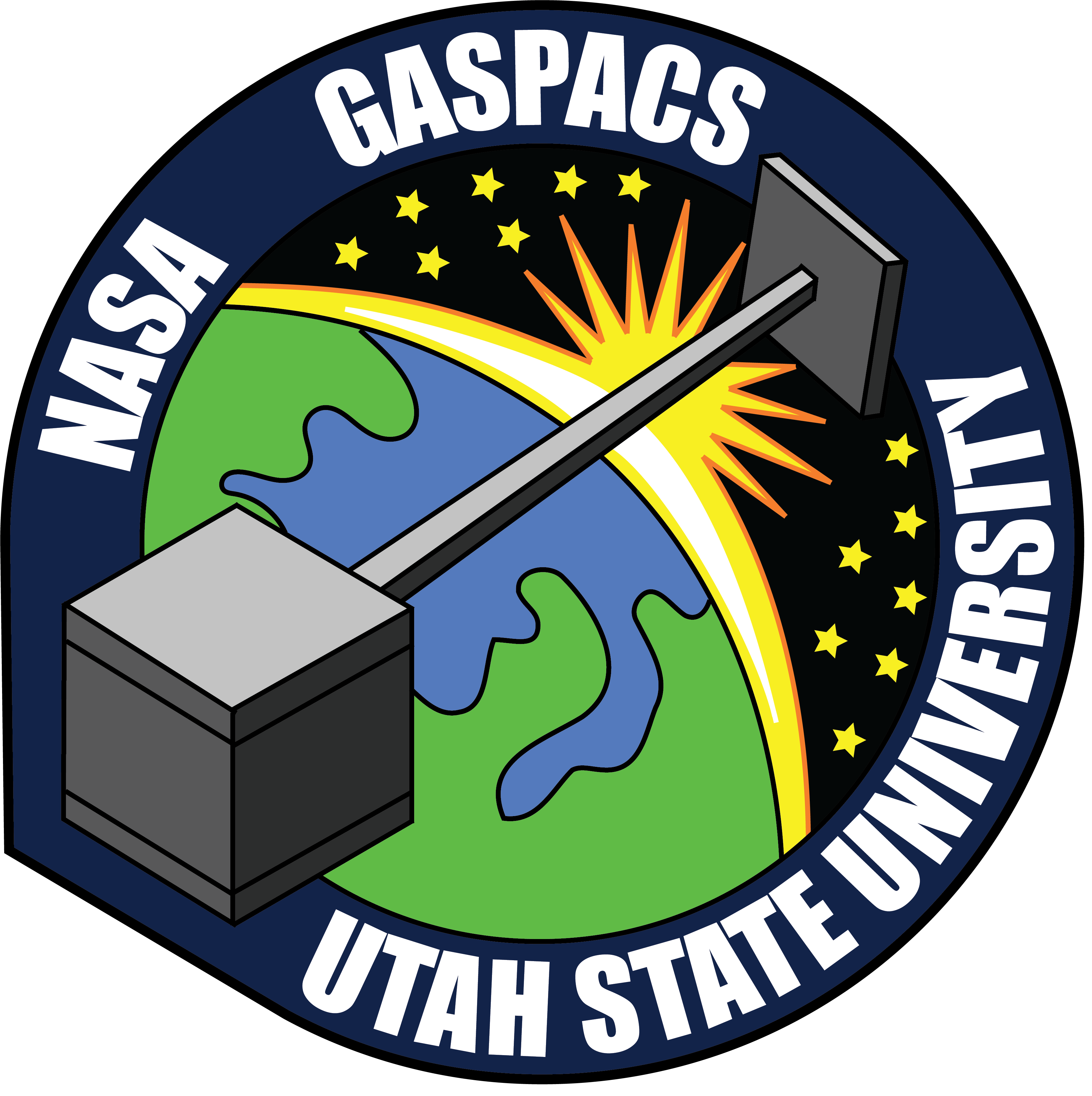
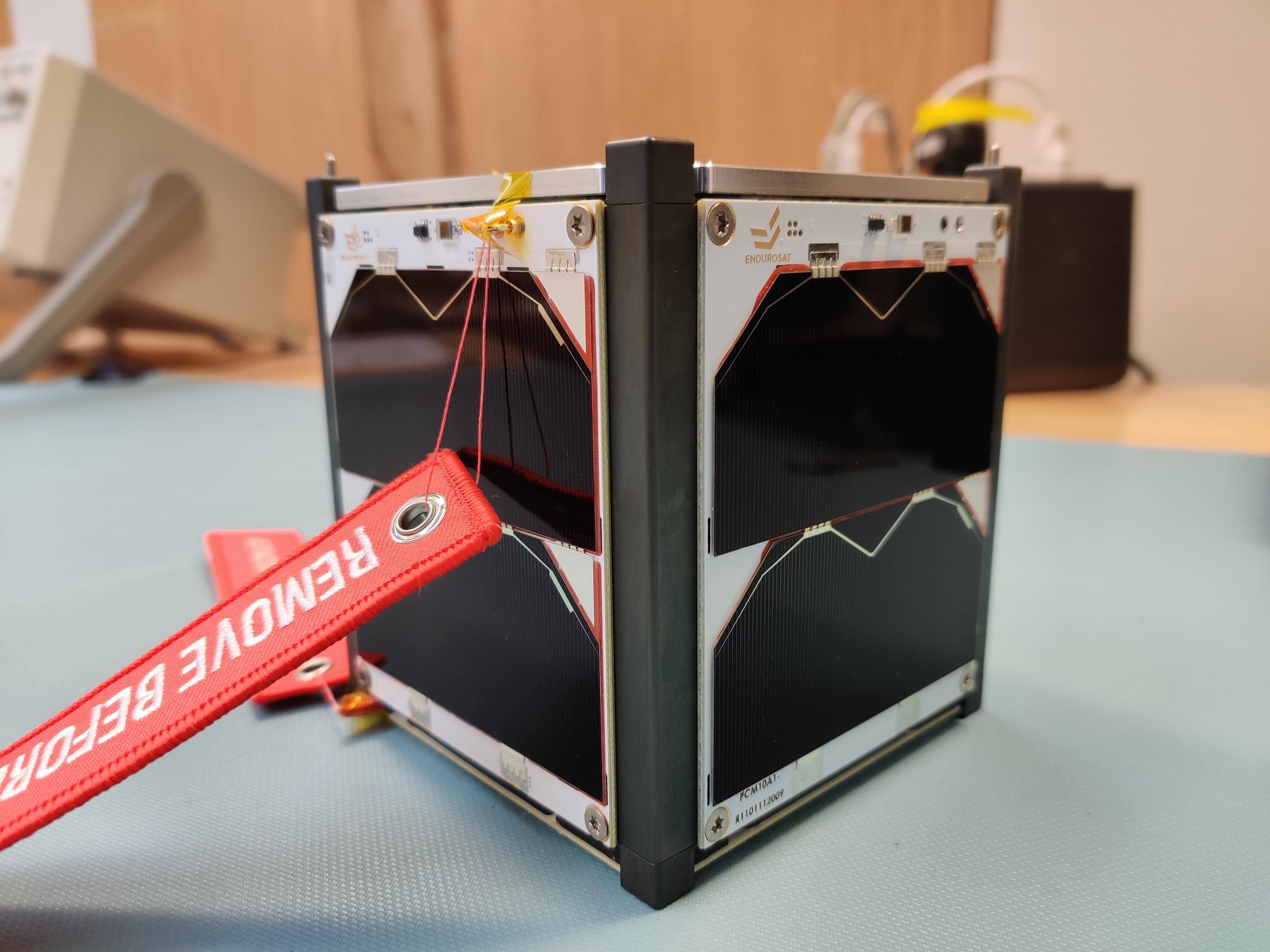
GASPACS Overview
The Get Away Special Passive Attitude Control Satellite (GASPACS) was a 1U CubeSat technology demonstration mission designed to test inflatable structures in space. The project aimed to present a possible solution to the limited capacities of spacecraft by providing an inflatable boom that could be packed into a small space and then expanded into something much larger. On GASPACS, the inflatable boom is utilized as a passive stabilization device referred to as the "AeroBoom". The AeroBoom interacts with the atmosphere in low Earth orbit and produces an aerodynamic drag that orients the satellite along its velocity vector. GASPACS was the world's first completely undergraduate CubeSat.
Mission Complete
The GASPACS mission lasted 117 days between deployment on January 26, 2022, and reentry on May 23, 2022. Despite facing numerous challenges and roadblocks along the way, GASPACS completed all its mission objectives and was widely acknowledged a great success.
The GAS Team was recognized by multiple figures for the success of GASPACS, including Kathy Lueders, NASA's Associate Administrator of the Human Exploration and Operations Mission Directorate.
For more on GASPACS, check out our Twitter and SatNOGS Dashboard below:
GASPACS Objectives
- Primary Objective: Deploy and photograph a meter-long inflatable boom from a 1U CubeSat in low Earth orbit and transmit a clear picture down.
- Secondary Objective: Measure attitude behavior of GASPACS to determine the effectiveness of the boom in passively stabilizing the CubeSat.
Mission Success!
- Just 18 hours after deployment from the International Space Station, GASPACS sent down an image of the AeroBoom fully deployed, completing the primary mission objective.
- The week after deployment, several periods of attitude data were received from GASPACS. Analyzing the magnetometer data from the periods showed that the AeroBoom was succeeding in its job of passively stabilizing the satellite, completing the secondary mission objective.
 Team Coordinator Jack Danos with GASPACS after a successful vibration test in August 2021.
Team Coordinator Jack Danos with GASPACS after a successful vibration test in August 2021. 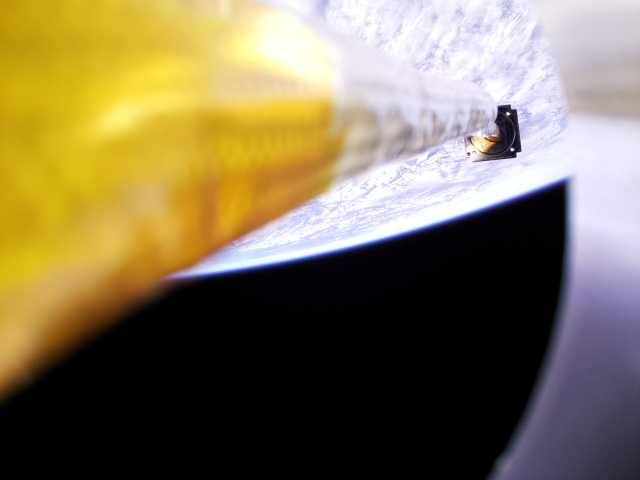
The GASPACS AeroBoom fully deployed over Earth. Image taken around March 19, 2022.
The AeroBoom
The meter-long AeroBoom is the inflatable payload of GASPACS and enables the satellite in passively stabilizing along the velocity vector. The satellite continues to spin about the Z axis due to various torques experienced in low Earth orbit. The AeroBoom takes its name from the aerodynamic drag that is caused by the inflated boom.
The AeroBoom is composed of three layers: an inner PVDF plastic, a middle braided fiberglass sleeve, and an outer FEP plastic. The inner PVDF layer is pressurized with 2.2 psia of air. In atmosphere, the AeroBoom lays flat, allowing easy packing into its container, the AeroBoom Box. Once in space, the pressure increases, inflating the AeroBoom. When deployment conditions are met, the restraining fishing line is burned, and the AeroBoom is deployed.
In space, the AeroBoom worked exactly as designed, fully deploying and passively stabilizing GASPACS. Eleven images were taken of the AeroBoom, including some incredible pictures over Earth.
A World's First for Undergrads
The Get Away Special Team is fully undergraduate, meaning all designing, testing, and building is done by the students. This rare opportunity gives great responsibility to members of the team and is often challenging, but it is also incredibly rewarding.
With GASPACS, the GAS Team became the first fully undergraduate team in the world to successfully build and send a CubeSat to space.
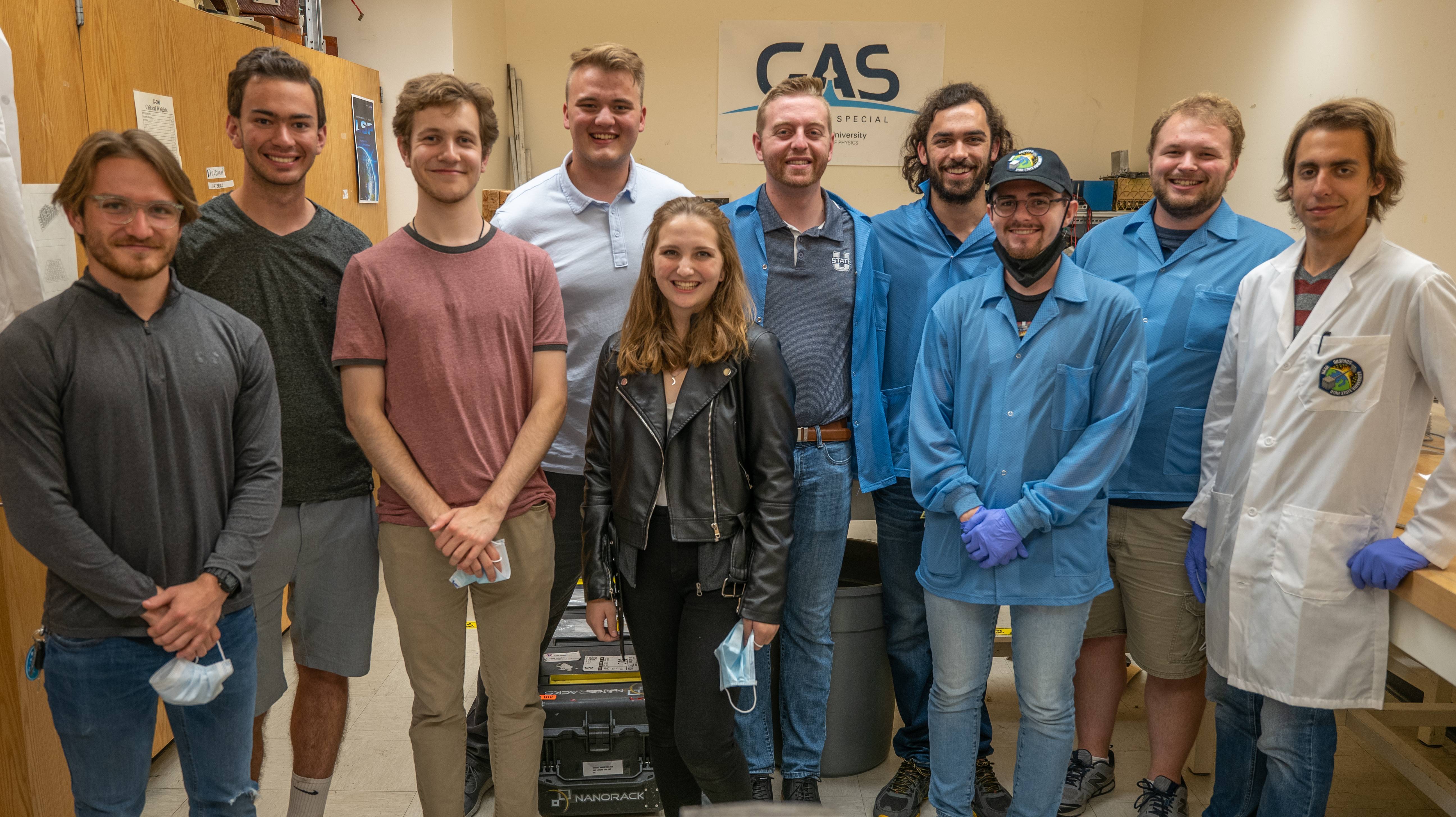 GAS Team members following the completion of GASPACS in August 2021.
GAS Team members following the completion of GASPACS in August 2021.
Fly High, Raspberry Pi
For the first time ever, a Raspberry Pi was used as a satellite's on-board computer. GASPACS' Raspberry Pi Zero handles all of the satellite's computing, running on software written entirely by the Software Team.
GASPACS used a Raspberry Pi camera to take images of the AeroBoom, which was also the first time a Pi camera had been used on a satellite.
This combination of Raspberry Pi components provided great success and some incredible images!
GASPACS Specifications
| Class | 1U CubeSat |
| Mass | 1.17 kg |
| Dimensions | 10 x 10 x 11.3 cm |
| Mission Type |
Technology demonstration |
| Payload | Deployable AeroBoom |
| On-Board Computer | Raspberry Pi Zero W |
| Electrical Board | In-house custom |
| Transceiver | EnduroSat UHF Transceiver |
| Battery | EnduroSat EPS |
| Structure | EnduroSat 1U Structure |
| Solar Panels | EnduroSat 1U Solar Panels |
| Antenna | EnduroSat UHF Antenna |
| Launch Vehicle | SpaceX Falcon 9 B1069.1 |
| Spacecraft | Cargo Dragon C209-2 |
| Launch Mission | SpaceX CRS-24 |
| Launch Date | December 21, 2021 |
| ISS Deployment Date | January 26, 2022 |
| Orbit | 416 x 428 km, 51.6 deg |
| Frequency | 437.365 MHz |
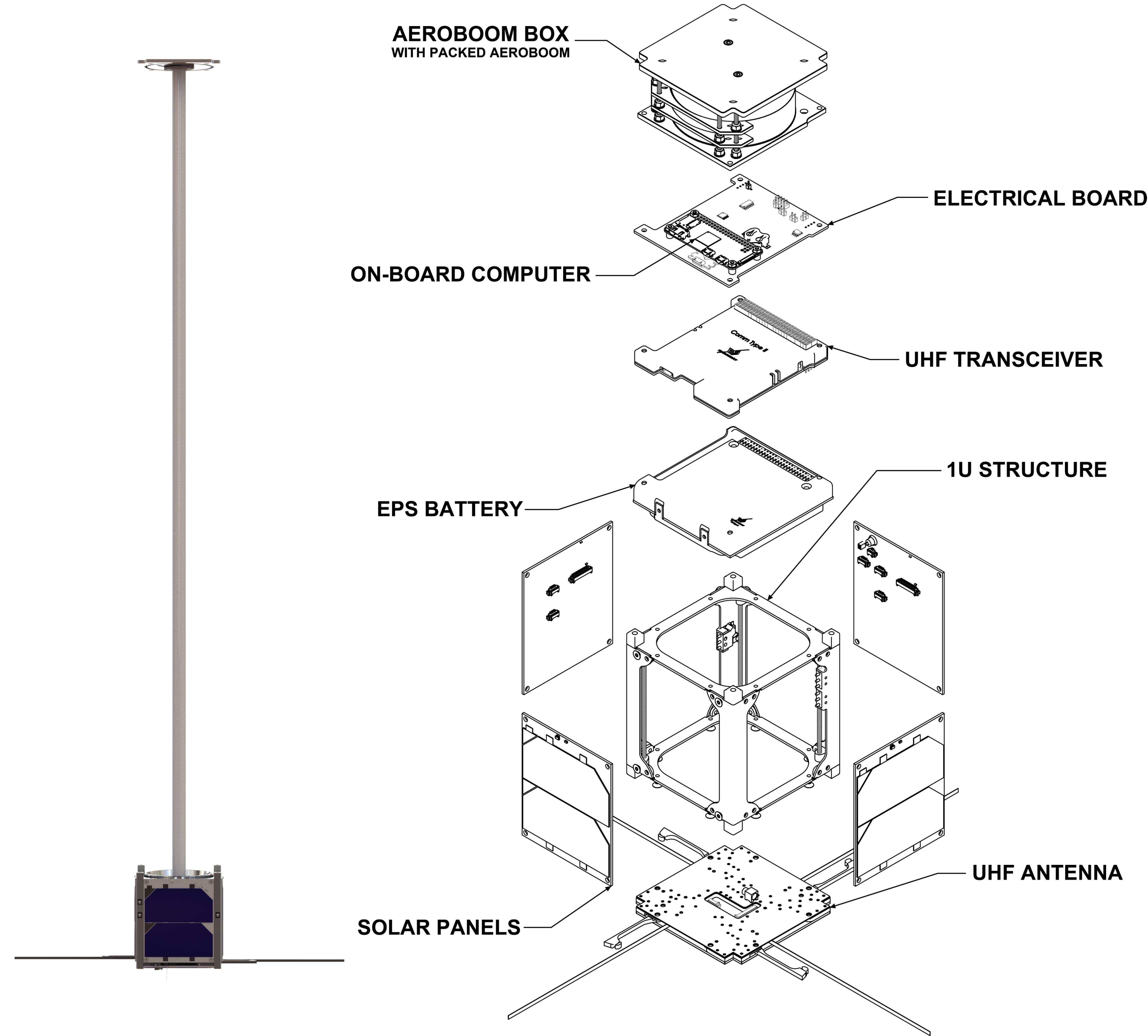
Explore the GASPACS Teams
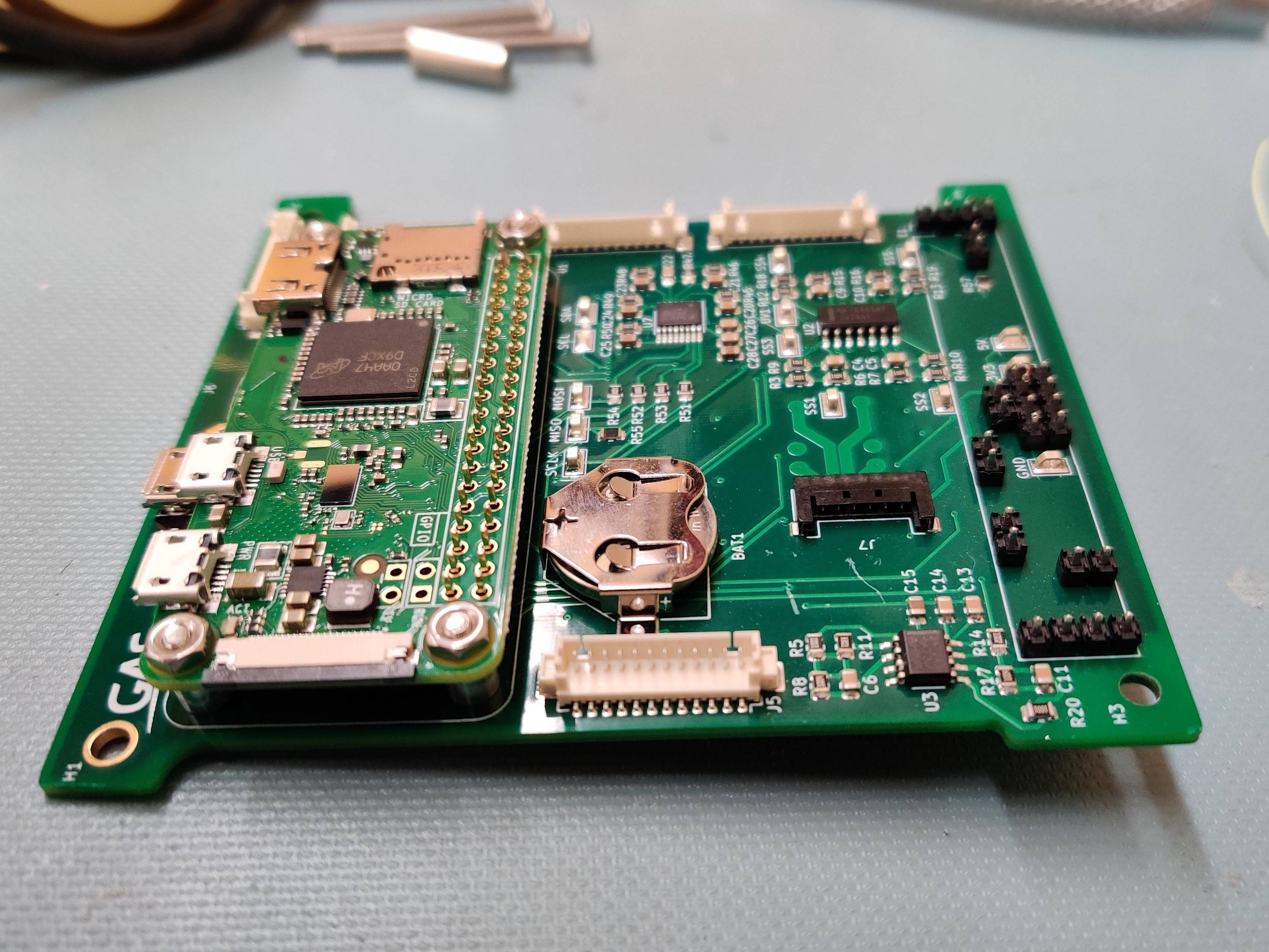
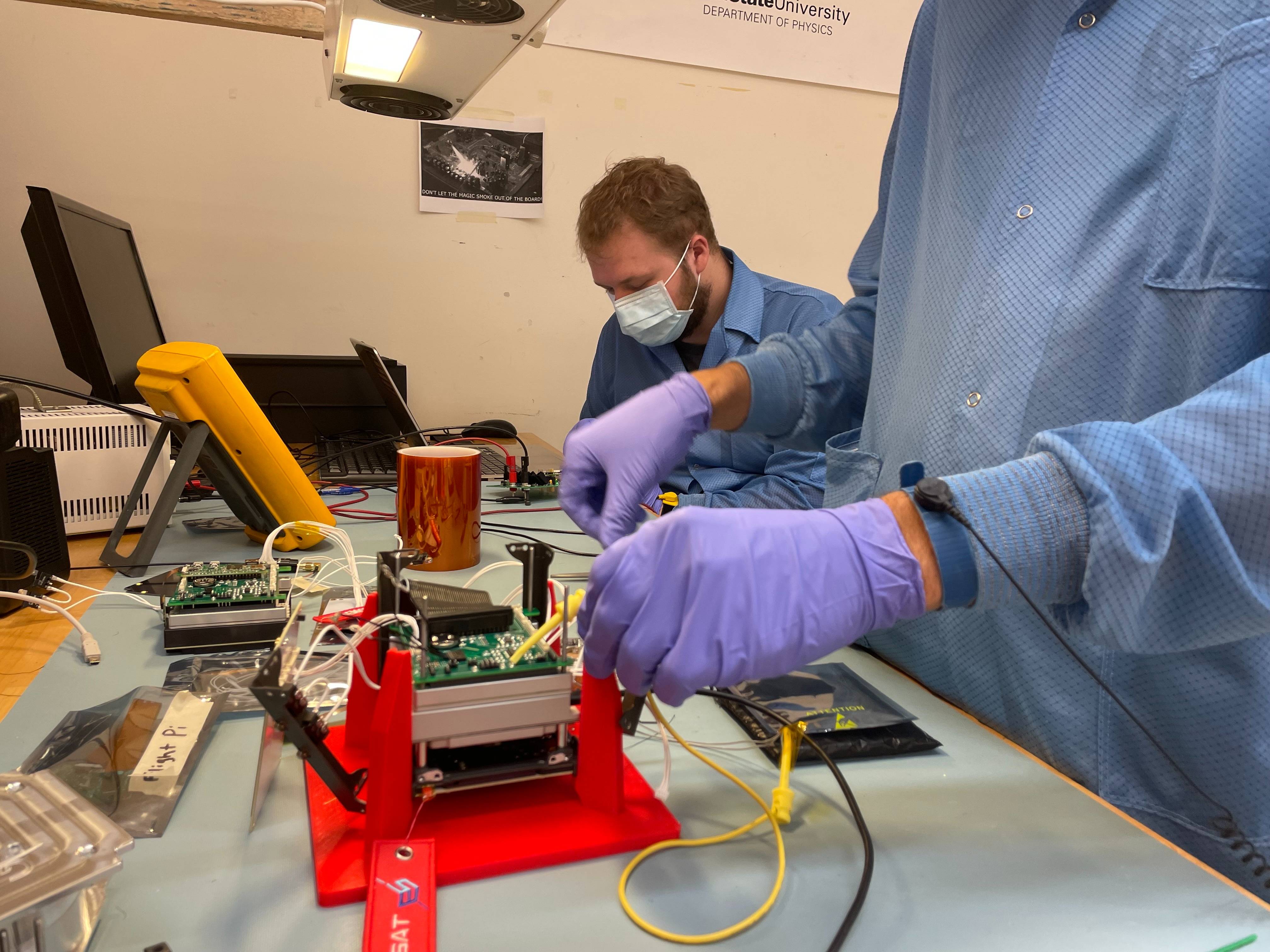
Electrical Team
GASPACS features a custom 3-layer PCB as its electrical board. The complex board features many sensors and inputs, including a magnetometer, accelerometer, UV sensor, and Raspberry Pi Zero W. Attached to the Raspberry Pi Zero W is a Raspberry Pi Camera, which is used to capture an image of the deployed AeroBoom. The board also powers the burn wire system, which is used to deploy the AeroBoom. Also on the electrical board is a DFRobot Beetle microcontroller that acts as a Watchdog, ensuring that the Raspberry Pi is functioning nominally. The Pi sends a signal to the Watchdog at 0.25 Hz. If the Watchdog does not receive a signal for more than five seconds, the Watchdog will power cycle the Pi in hopes that the Pi will return to normality after reboot.GASPACS uses the EnduroSat EPS and 1U Solar Panels for its power generation and storage.
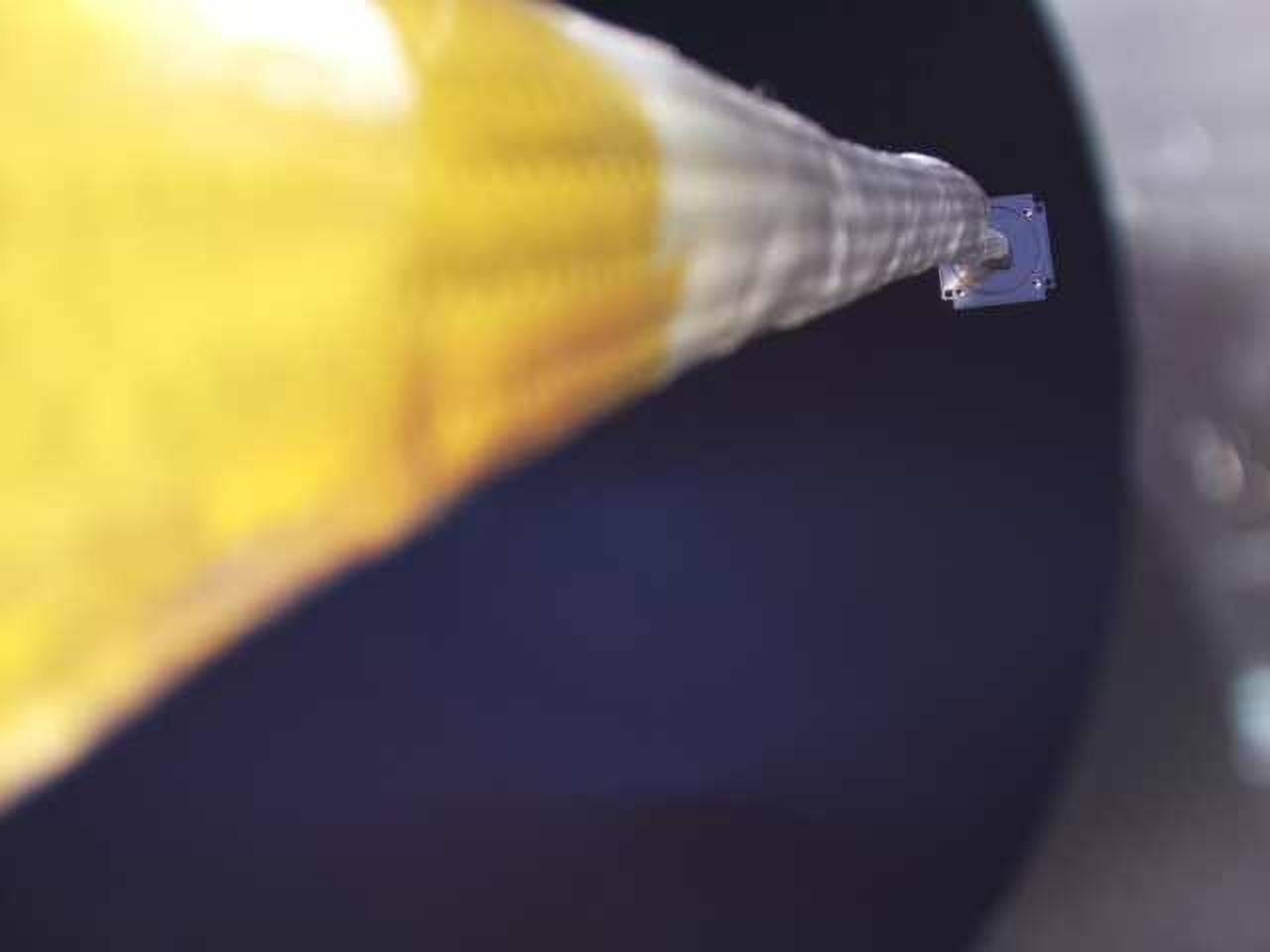
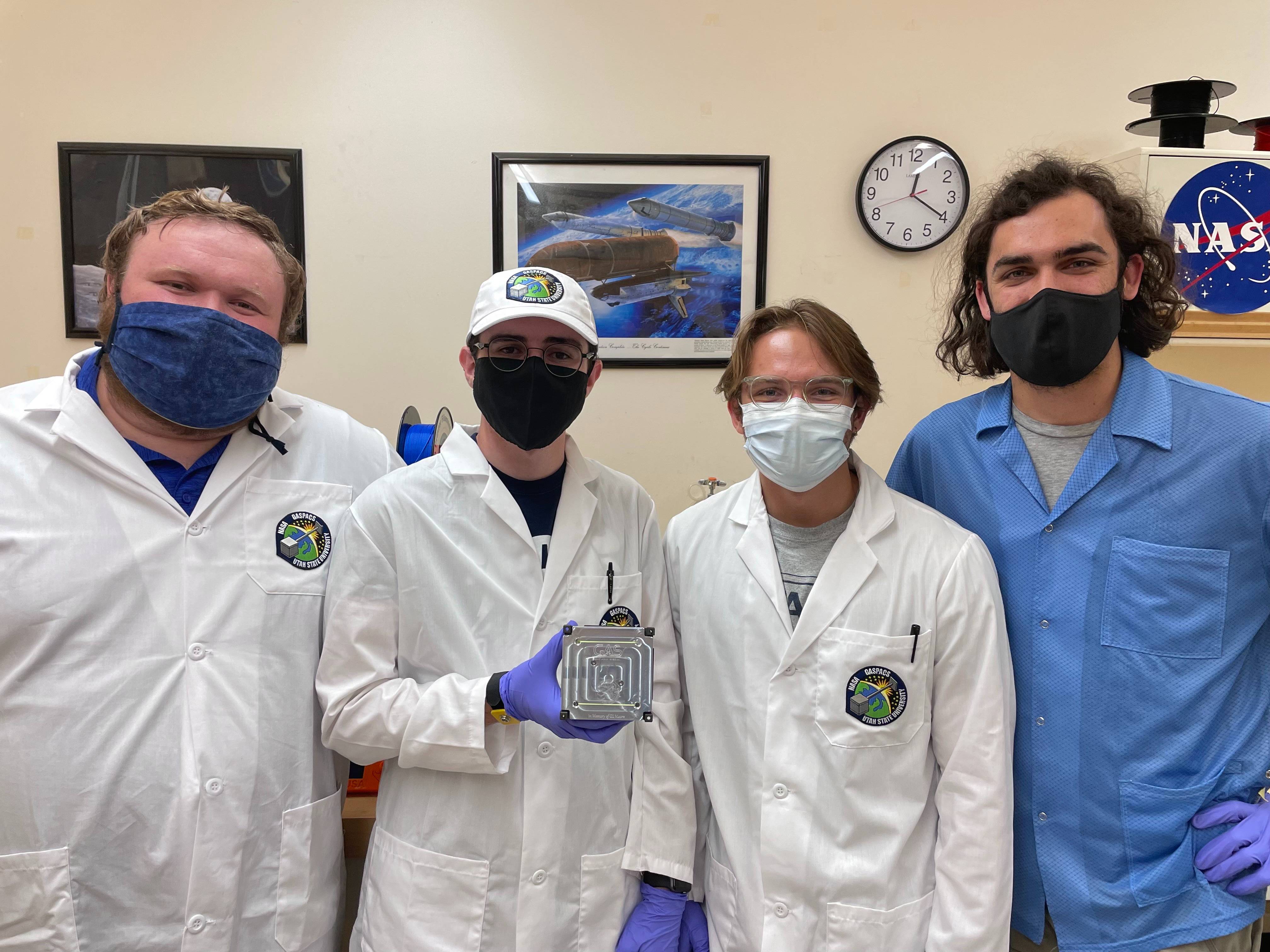
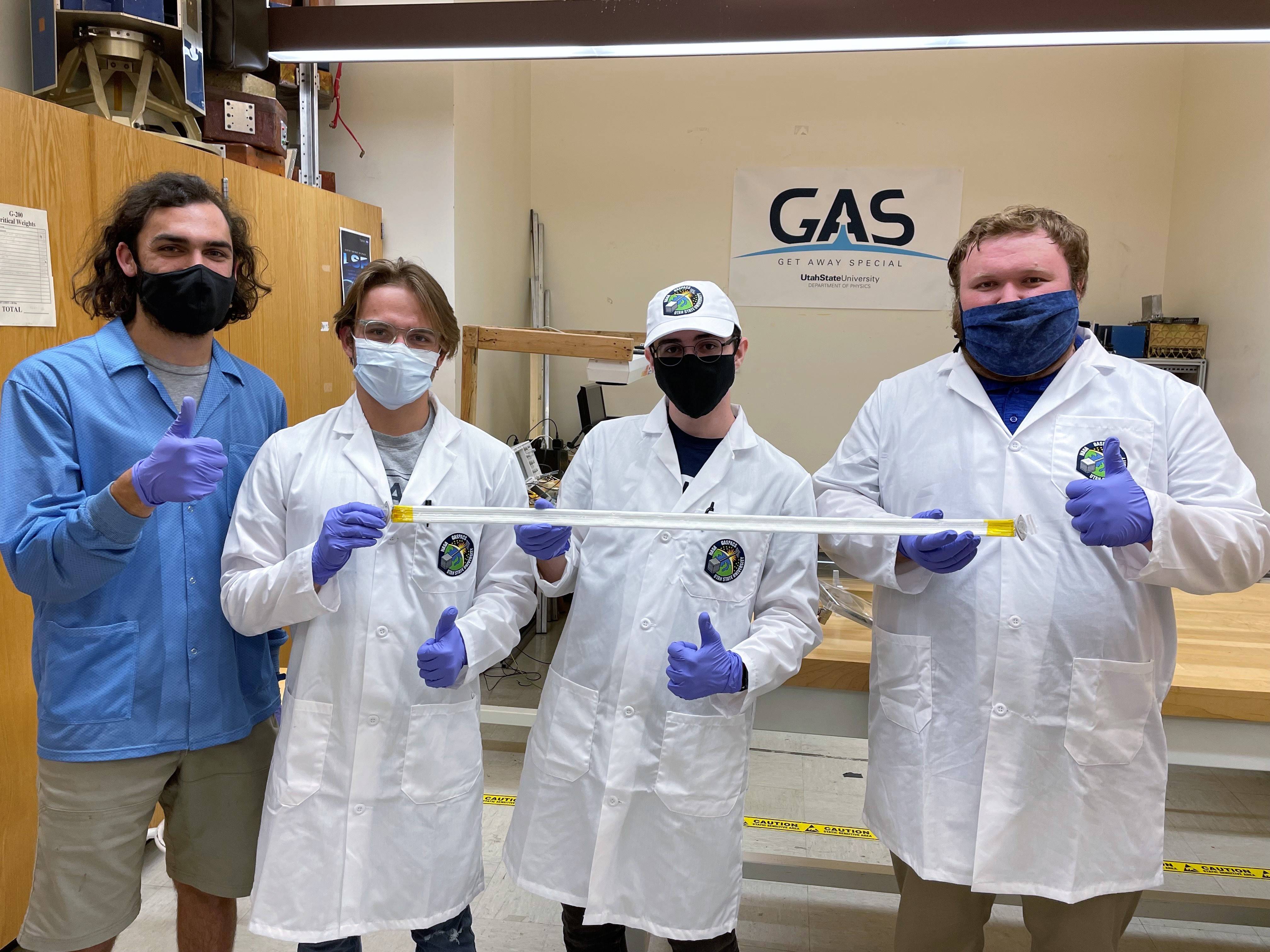
Mechanical Team
The AeroBoom Payload is the main feature of GASPACS, consisting of the novel AeroBoom and its container, the AeroBoom Box.
The AeroBoom is carefully constructed to withstand AeroBoom deployment and the harsh environment of space. The three AeroBoom layers work together to provide the ideal AeroBoom deployment:
- The inner plastic layer made from polyvinylidene fluoride (PVDF). Pressurized with 2.2 psia of atmospheric air, the PVDF layer provides the AeroBoom's inflation due to the pressure difference in the vacuum of space.
- The middle braided fiberglass sleeve. The fiberglass acts as a cushion between the two other layers, helping prevent the plastics from sharp folds or a violent deployment.
- The outer plastic layer made from fluorinated ethylene propylene (FEP). The FEP provides protection to the rest of the AeroBoom from any unexpected conditions. The FEP layer also holds the disk clamps that are used to secure the AeroBoom to the satellite.


Software Team
GASPACS' on-board computer is a Raspberry Pi Zero W running Raspbian Lite as its operating system. The majority of the flight logic software is programmed in Python. The decision to use Python and a Raspberry Pi was made for ease of accessibility, allowing any first-year student to be able to quickly learn how the code works and how they can build upon it. Since Python is a relatively slow language, the demanding task of collecting and transmitting data required something faster. Therefore, C was chosen as the designated language for the data transmission program. The flight logic features six mission modes that it progresses through to complete the overall mission: Boot Mode, Antenna Deployment Mode, Pre-AeroBoom Deployment Mode, AeroBoom Deployment Mode, Post-AeroBoom Deployment Mode, and Communications-TX Mode.
The GAS Team takes pride in its software and in lowering the costs of satellite development. You can find the open-source GASPACS software on the GASPACS CubeWorks GitHub page.
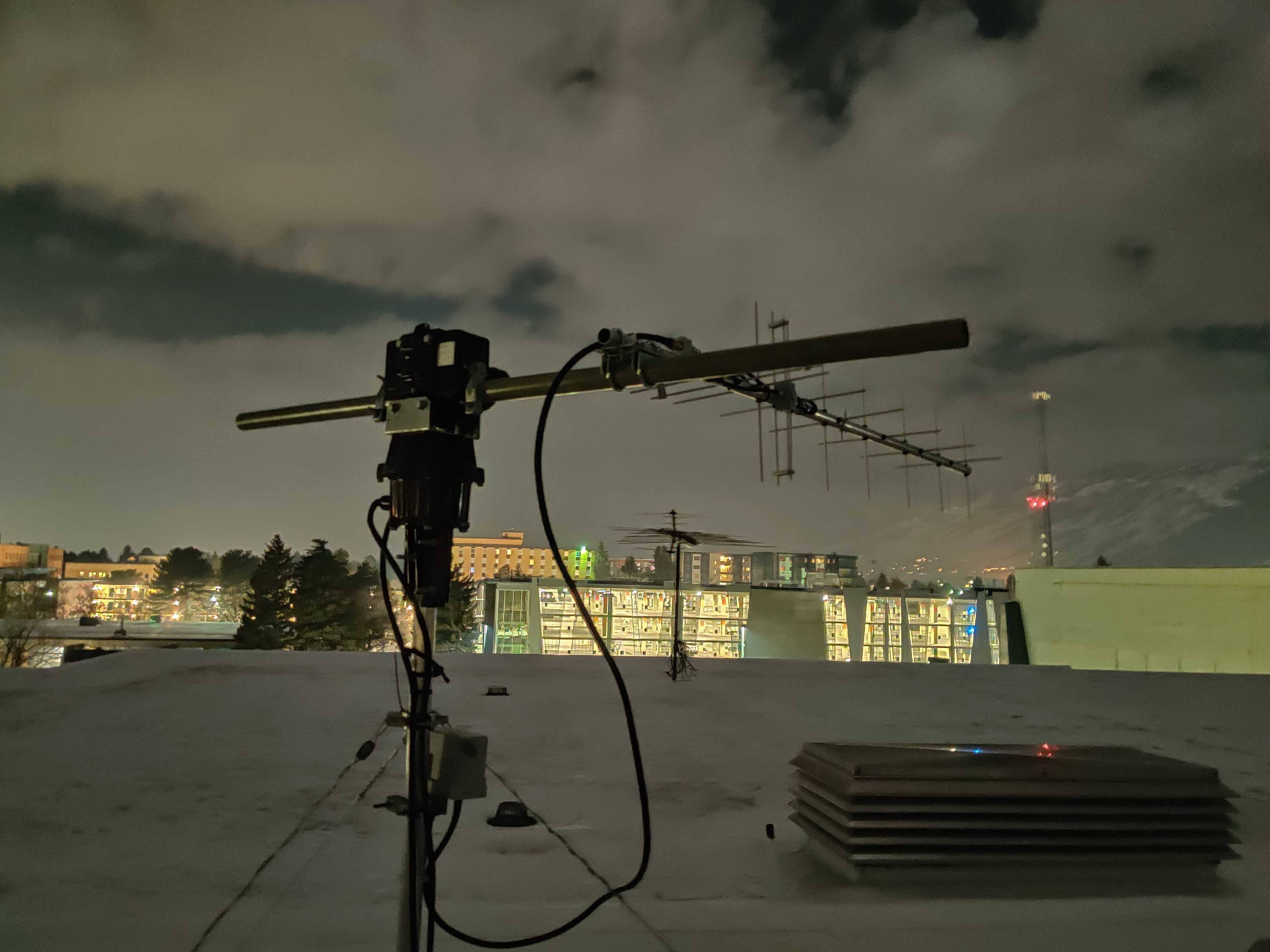
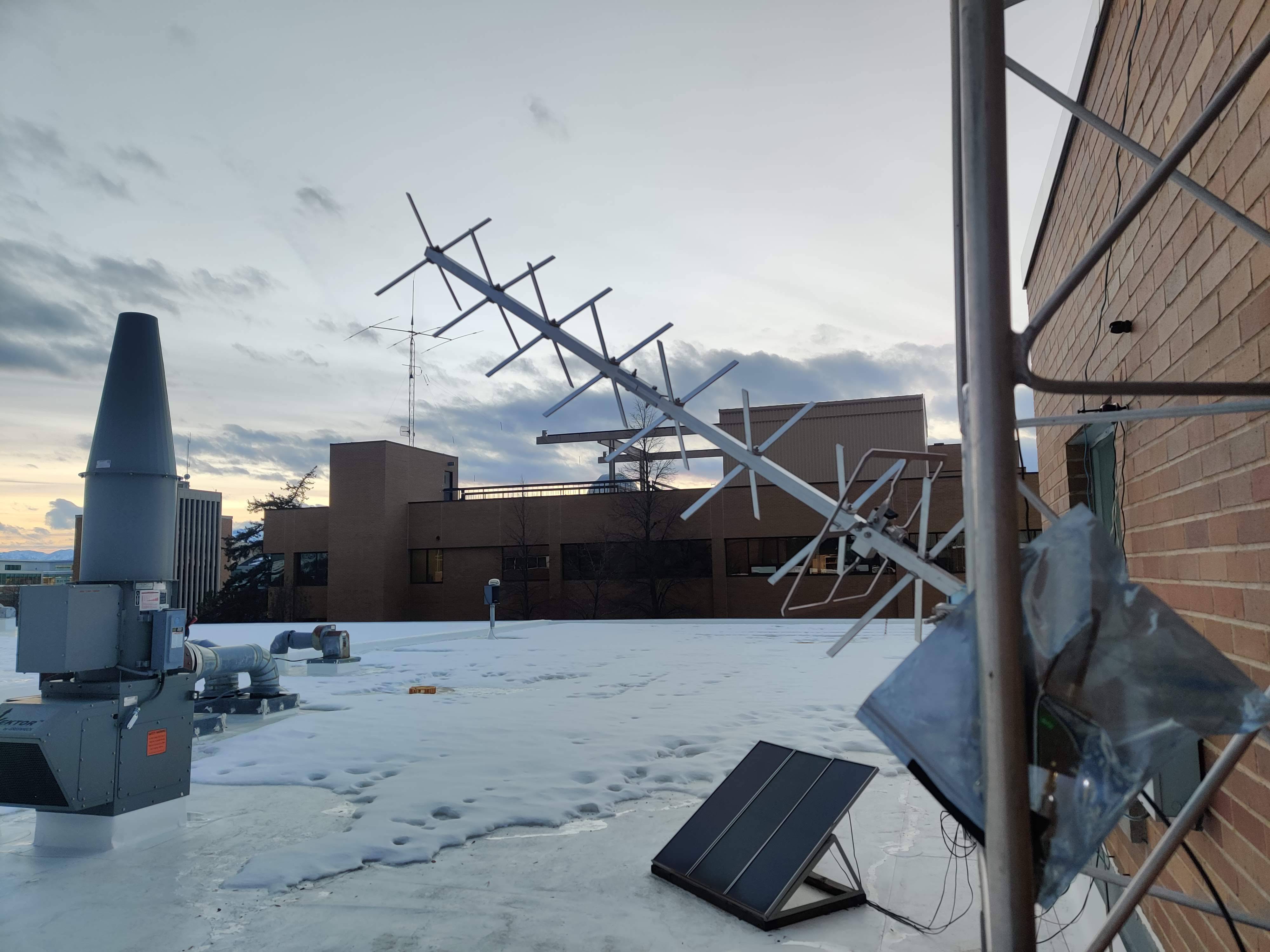
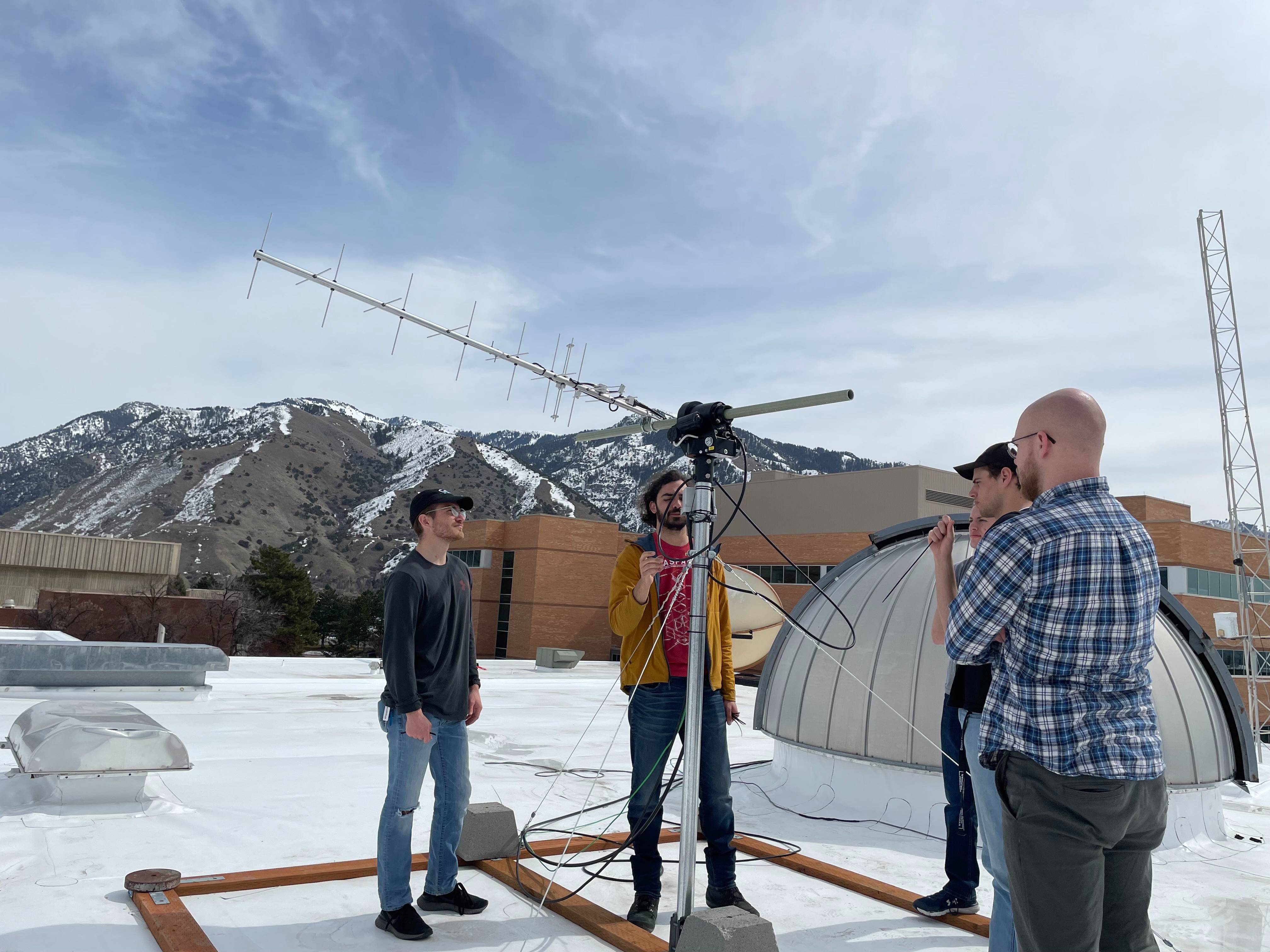
Communications Team
The Communications Team constructed the GAS Team ground station that sits on top of the Engineering Lab building. The ground station is a part of SatNOGS, an online, crowd-sourced, global network of satellite ground stations that offers users the ability to schedule satellite observations on any station in the network. Using the 400+ ground station network is what allowed the GAS Team to receive the very first audio beacon from GASPACS on a ground station located in Tokyo, Japan.The GAS Team has two ground stations. The main ground station (left) is our rotator setup and is primarily used for communications with GASPACS. The secondary ground station (middle) is a fixed antenna used to provide additional data.
For more details about GASPACS communications, visit the GASPACS CubeSat Communications Information GitHub page.
NASA's CubeSat Launch Initiative
The GASPACS mission is sponsored by NASA's Launch Services Program through the CubeSat Launch Initiative (CSLI). The GASPACS project proposal was submitted to and selected by NASA in 2014. Through CSLI, NASA provides the launch opportunity for the satellite, worth up to $300,000. GASPACS launched on the SpaceX CRS-24 International Space Station resupply mission. The launch featured CSLI's Educational Launch of Nanosatellites (ELaNa) 38, of which GASPACS was manifested on as one of four CubeSats.

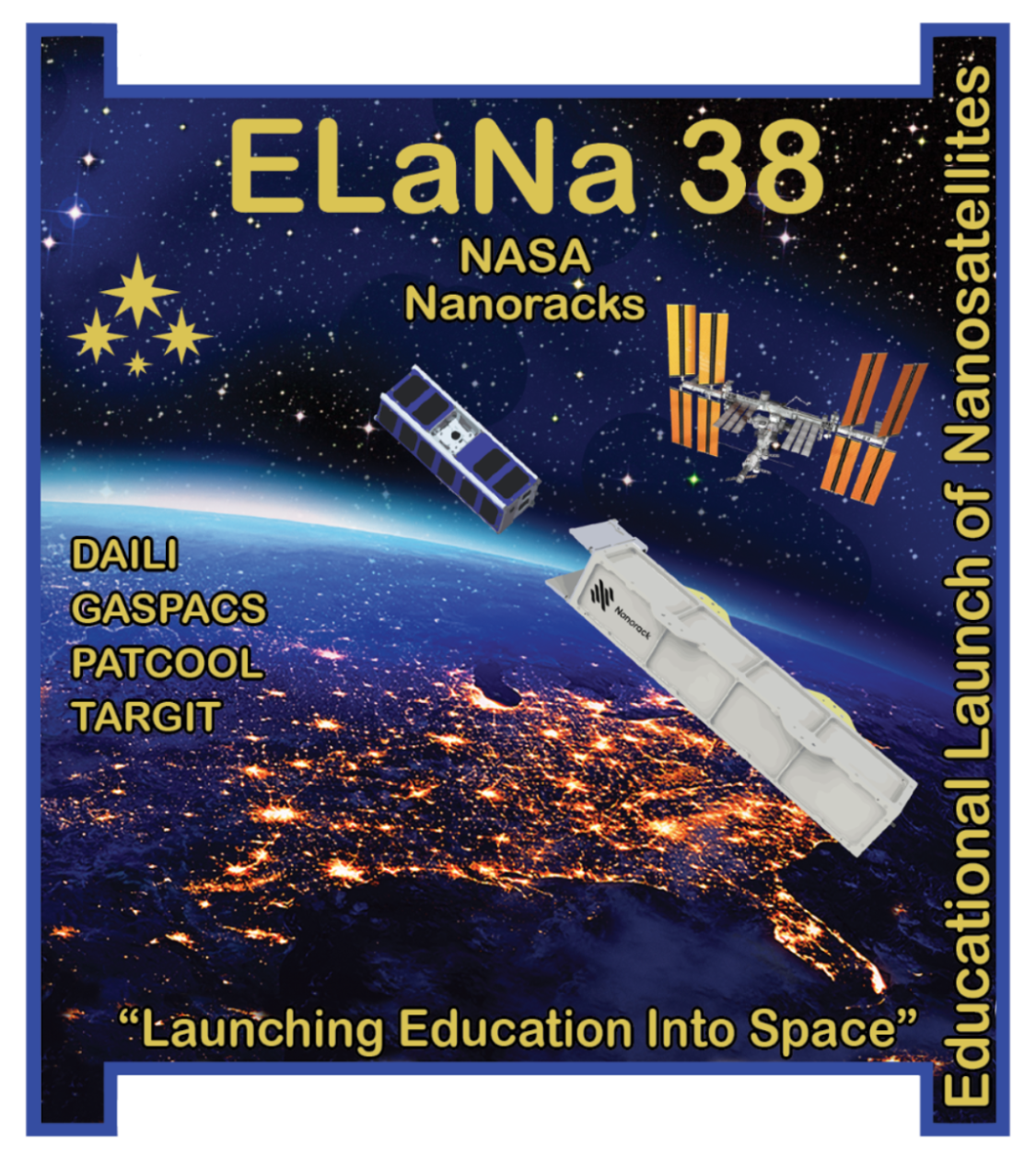
Nanoracks
As part of the CSLI process, CubeSat teams are paired with a third-party mission manager that facilitates the delivery and integration process of the satellite with the launch vehicle. GASPACS was teamed up with the Houston, Texas company Nanoracks. Nanoracks provides tools, hardware, and services that allow other companies, organizations and governments to conduct research and other projects in space. The GAS Team collaborated extensively with Nanoracks to ensure that GASPACS would survive launch and meet all NASA and ISS safety standards.

GASPACS Timeline
| Major Events | Date |
|---|---|
| LEOP repurposed as GASPACS | Early 2013 |
| CSLI Proposal Accepted | February 6, 2014 |
| High Altitude Balloon Tests | 2016 - 2017 |
| Preliminary Design Review | April 16, 2019 |
| FlatSat Integration Complete | October 26, 2020 |
| Critical Design Review | December 4, 2020 |
| Descope and Resin Removal | May 25, 2021 |
| GASPACS Complete | August 17, 2021 |
| Vibration Test | August 20, 2021 |
| Delivery and Integration | September 23, 2021 |
| Launch | December 21, 2021 |
| ISS Deployment and Mission Start | January 26, 2022 |
| Mission Operations | January 26, 2022 - May 23, 2022 |
| Deorbit and Mission End | May 23, 2022 |
10+ Years in the Making
The GASPACS project existed for over 10 years in many different forms before becoming what it is today. GAS Team plans of a CubeSat can even be traced back to 2004! The idea of a passively stabilizing boom, however, dates back only twelve years.
In 2010, the GAS Team began the Low Earth Orbiting Photographer (LEOP) project. The goal of LEOP was to develop a cheap Earth observation solution in the form of a CubeSat, designed to photograph various landmarks all over the globe. It was eventually realized that in order to photograph the Earth, the satellite would need sufficient attitude control to maintain its pointing. Opposed to active attitude control methods, the team sought a passive solution to keep LEOP aimed at the Earth. They decided to use a meter-long spring tape measures as a gravity gradient boom.
In 2013, the LEOP project was renamed to the Get Away Special Passive Attitude Control Satellite (GASPACS). Along with this change was a shift in mission objectives. The spring tape measure boom was changed to a meter-long inflatable boom and the main objective of GASPACS became studying and demonstrating the use of the boom in passively stabilizing the satellite. The boom would use UV-curing epoxy to rigidize once deployed, and then stabilize due to gravity gradient forces.
In 2014, research found that the gravity gradient effects would not be sufficient to stabilize GASPACS, so the focus changed to aerodynamic drag instead. It was at this time that the boom was renamed to the AeroBoom and GASPACS began to finally take its modern form.
CSLI Proposal Accepted
In 2013, James Gardiner submitted the Get Away Special Passive Attitude Control Satellite proposal to NASA's CubeSat Launch Initiative. GASPACS was then selected by NASA in 2014 as part of CSLI Selection 5, along with 15 other projects.
High Altitude Balloon Tests
Throughout 2016 and 2017, the team flew several high altitude balloon flights with the goal of testing the AeroBoom. Using the high altitude balloon flights allowed the team to test AeroBoom deployments in a space-like environment. The tests also featured the first uses of the Raspberry Pi and Raspberry Pi Camera.
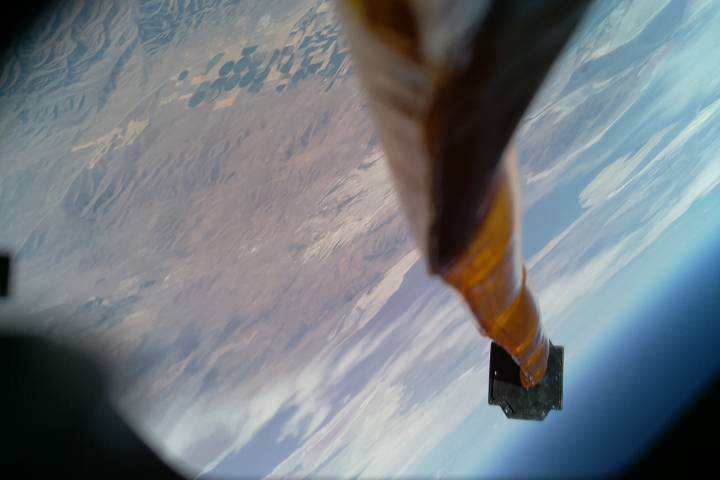 A deployed AeroBoom captured on a high altitude balloon flight on July 29, 2017.
A deployed AeroBoom captured on a high altitude balloon flight on July 29, 2017.
Preliminary Design Review
The GASPACS preliminary design review (PDR) was held on April 16, 2019. The purpose of PDR is to present a "rough draft" plan of the satellite to various professionals, such as industry employees and professors. The feedback gathered from the attendees is vital to development and ensuring that the project is on the right path. Download the GASPACS PDR presentation here.
FlatSat Integration Complete
In October 2020, the GASPACS FlatSat was completed. FlatSat is GASPACS's first full prototype, made up of the crucial components needed to test the entire system. The name FlatSat is commonly used for satellite prototypes where the components are layed out on a table rather than in stacked flight configuration. FlatSat allowed the first tests that involved all components of GASPACS and helped verify that the system worked properly as a whole.
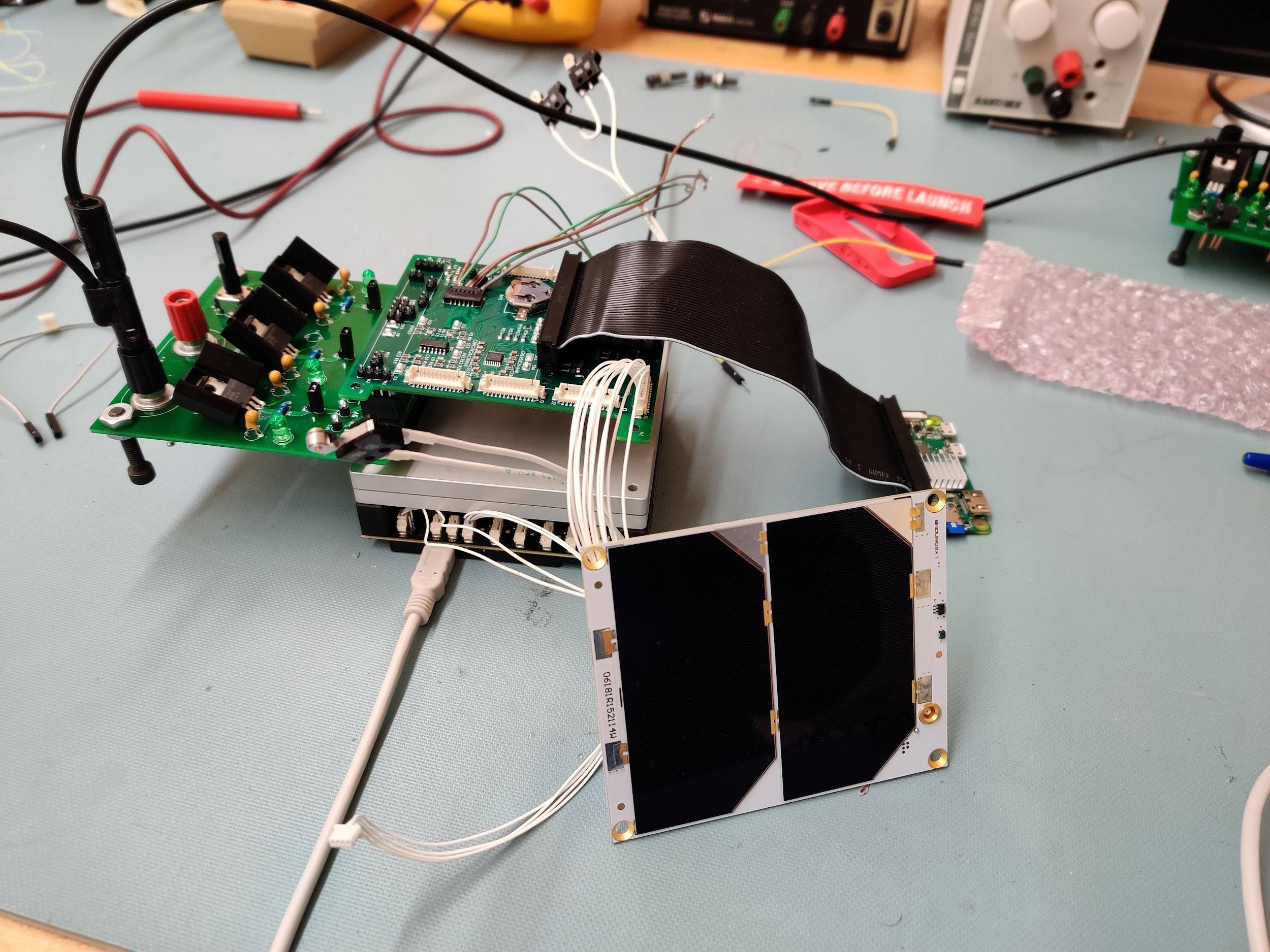
The GASPACS FlatSat in October 2020.
Critical Design Review
The GASPACS critical design review (CDR) was held on December 4, 2020. CDR is similar to PDR in that you present the current status of the satellite to various professionals, such as industry employees and professors. CDR, however, is meant to represent the near-final design of the satellite. The CDR program was much more extensive, containing over six hours of detailed system presentations. Feedback from CDR was highly positive, with all attendees expressing confidence in GASPACS. Download the GASPACS CDR presentation package here.
Descope and Resin Removal
The AeroBoom originally featured a UV-curing resin that would rigidize the AeroBoom after its deployment. Any resin that was to be used would have had to passed NASA's outgassing requirements. However, this wasn't a worry here, as the resin would be hermetically sealed within the AeroBoom, never experiencing vacuum. Prior research done by the team concluded that the resin would not have any chemical effects on the materials of the AeroBoom, but tests and discussions with the resin manufacturer proved otherwise. In the summer of 2021, worries arose both within the team and NASA that the AeroBoom was not as chemically sound as was previously thought. If the resin were to remain in the design, several more methods of containment would have needed to been added to prevent the possibility of the resin outgassing. Since GASPACS was so far in development, the decision was made to remove the resin on May 25, 2021. This decision was made based off of two things: 1. Removing the resin improved confidence in the functionality of the AeroBoom and removed the risk of the resin outgassing onto the camera. 2. The last thing the team wanted to do was have the resin outgas and put the ISS astronauts at risk of hazardous gases.
GASPACS Complete
After more than seven years since its CSLI proposal, GASPACS was finally completed on August 17, 2021. The project went through several teams of varying leadership, where each change resulted in a loss of knowledge that would set it back. Although the overall concept of GASPACS remained the same for its entire lifetime, nearly all of the design and work that made the final GASPACS was done between 2019 and 2021. The effort was led by Team Coordinator Jack Danos, whose leadership and passion for the project kept GASPACS alive in its most crucial moments, including throughout the COVID-19 pandemic. Danos pushed the team more than ever before and held everyone to high standards, which is one of the main reasons for the ultimate success of GASPACS. Other significant contributors to the completed GASPACS include:
- Electrical Team Leads Ben Lewis and Nik Clark
- Mechanical Team Leads Carter Page and Logan Freeman
- Software Team Lead Shawn Jones
- Communications Team Lead Daniel Ashby
- Team Members Alex Allgrunn, Andrew Nelson, Cooper Gowan, DJ Combs, Donna Metcalf, Evan Anderson, Josh Hessing, Ryan King, and Tom Christensen
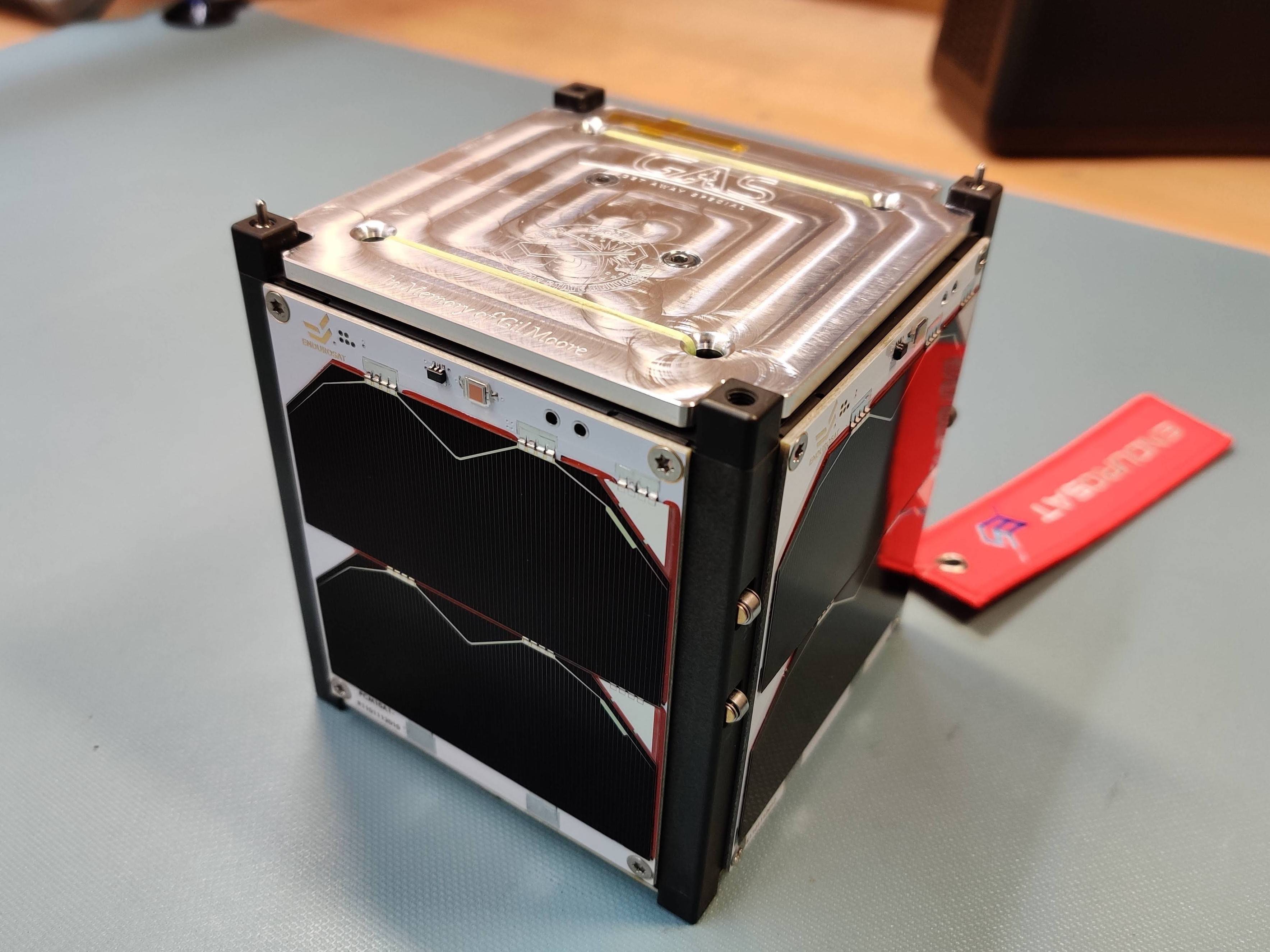 The completed GASPACS CubeSat.
The completed GASPACS CubeSat.
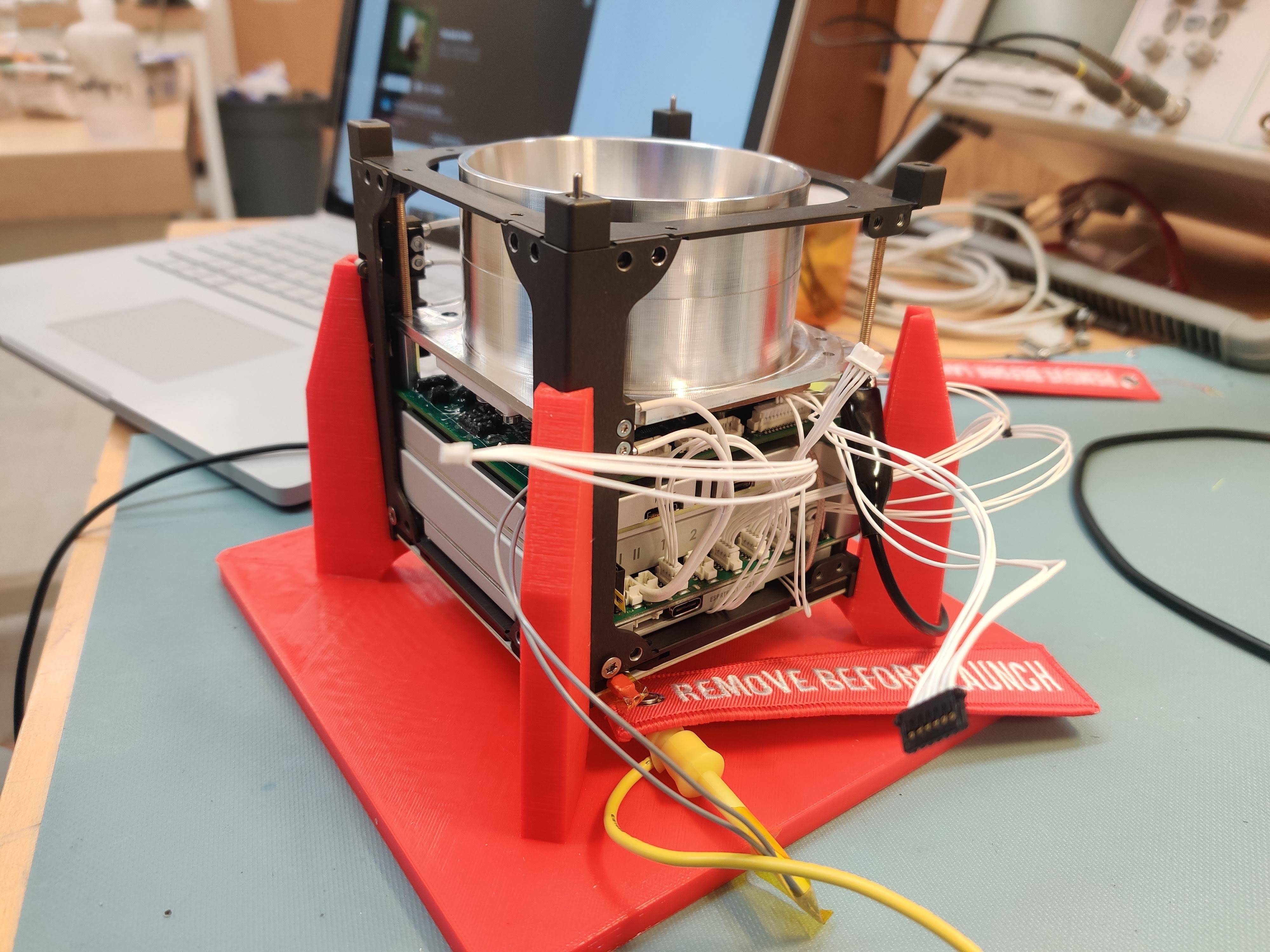 GASPACS during final construction.
GASPACS during final construction.
Vibration Test
GASPACS successfully vibration tested on August 20, 2021, at a testing facility in Ogden, Utah. Vibration testing is required by Nanoracks and is the final test performed on a satellite. The testing simulates the vibrations felt as the satellite launches on top of the rocket.
The testing was performed with GASPACS in a Nanoracks CubeSat Deployer (NRCSD), similar to the configuration GASPACS would travel to space in. Nanoracks partners Julia and Cole flew in to oversee the testing.
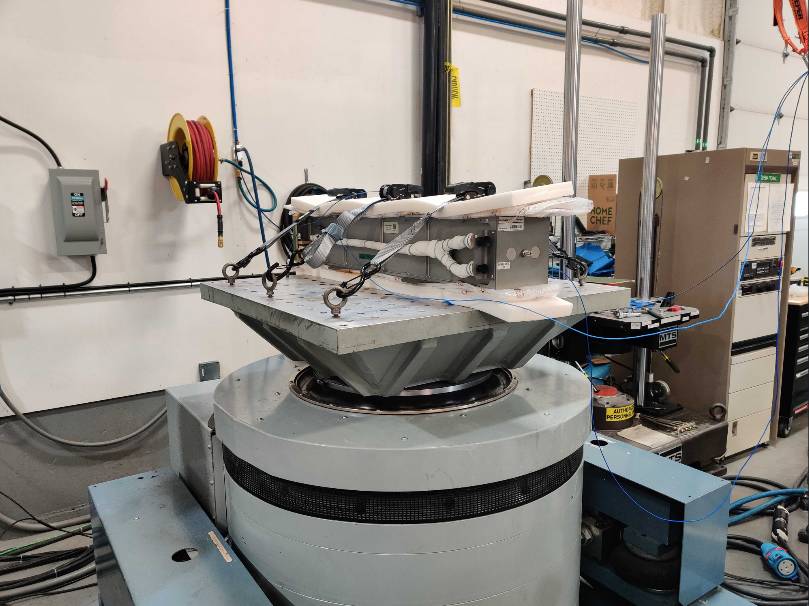 GASPACS in the NRCSD during a vertical vibration test.
GASPACS in the NRCSD during a vertical vibration test.
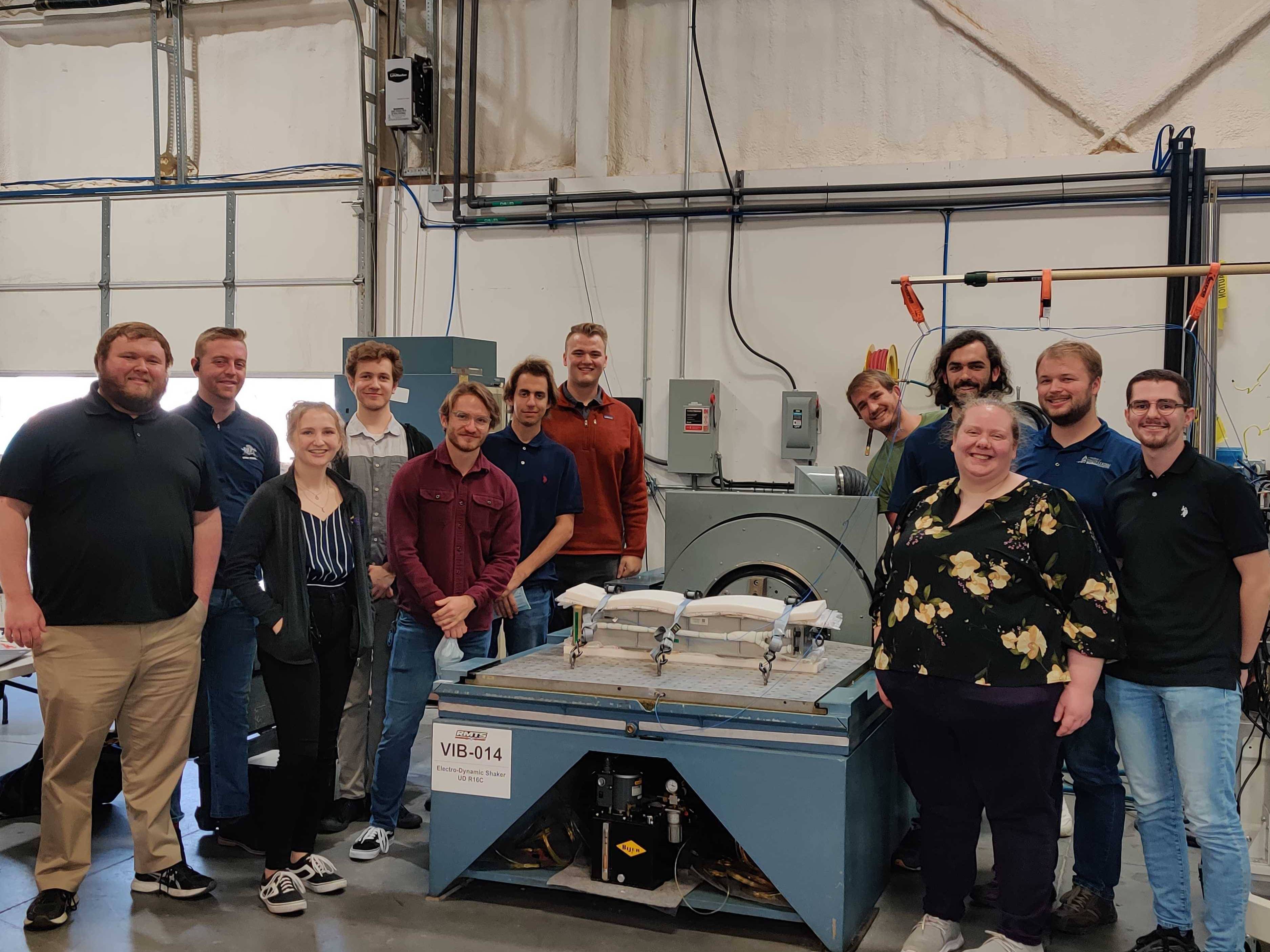 The GAS Team and Nanoracks partners at the GASPACS vibration test.
The GAS Team and Nanoracks partners at the GASPACS vibration test.
Delivery and Integration
On September 23, 2021, Jack Danos, Carter Page, and long-time team advisor Dr. Jan Sojka traveled to the Nanoracks office in Houston, Texas for the delivery and integration of GASPACS.
GASPACS was transported using a custom ESD-safe 3D printed container and a Pelican case. The case was flown as a carry on.
Final fit checks were performed, ensuring GASPACS would fit and slide properly within the Nanoracks CubeSat Deployer (NRCSD). After fit checks and the final weighing of the satellite, GASPACS was integrated into the NRCSD along with FEES-2, a 0.3U CubeSat from Italian company GP Advanced Projects.
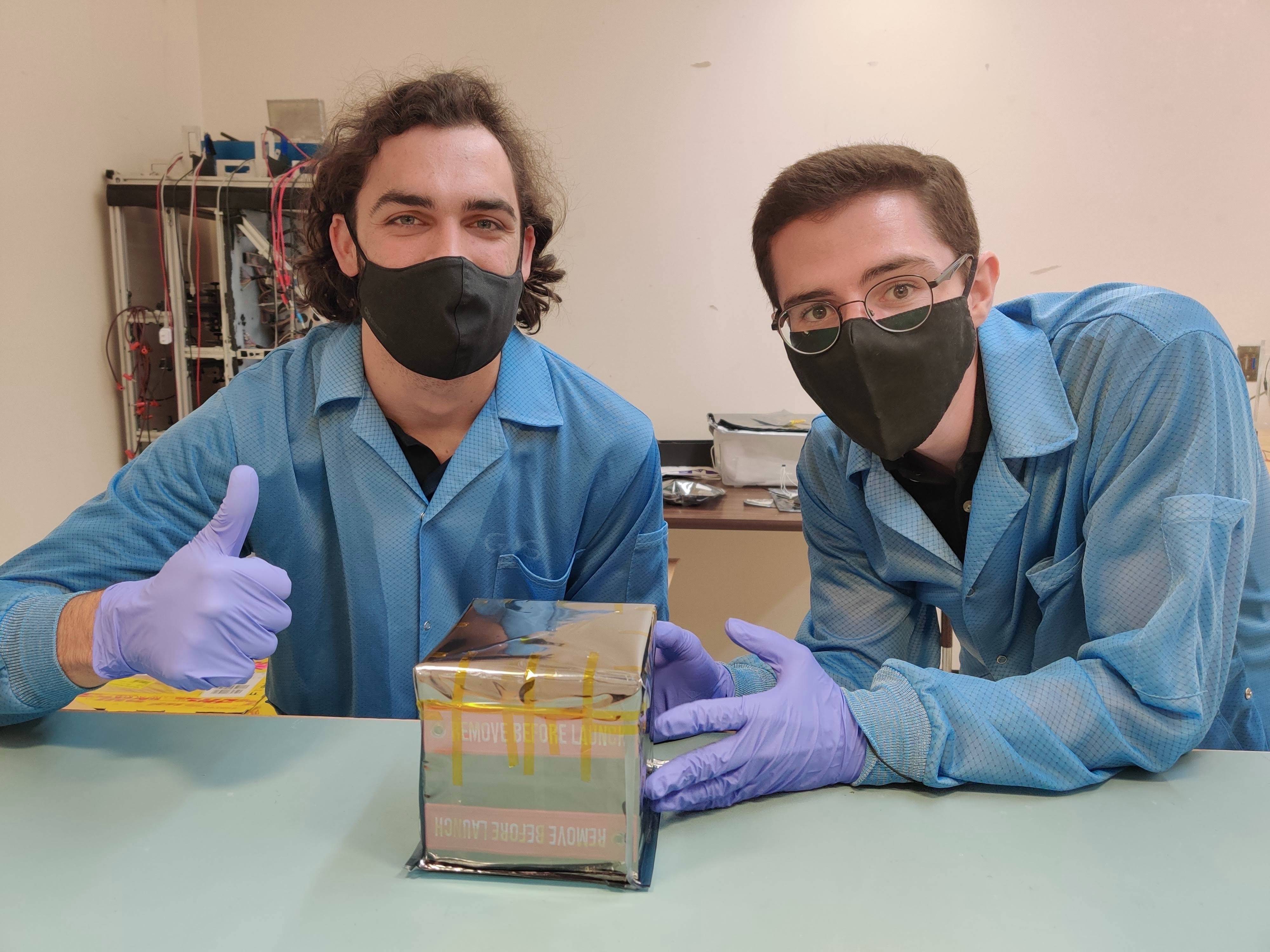
Danos and Page with GASPACS packaged in its traveling case.
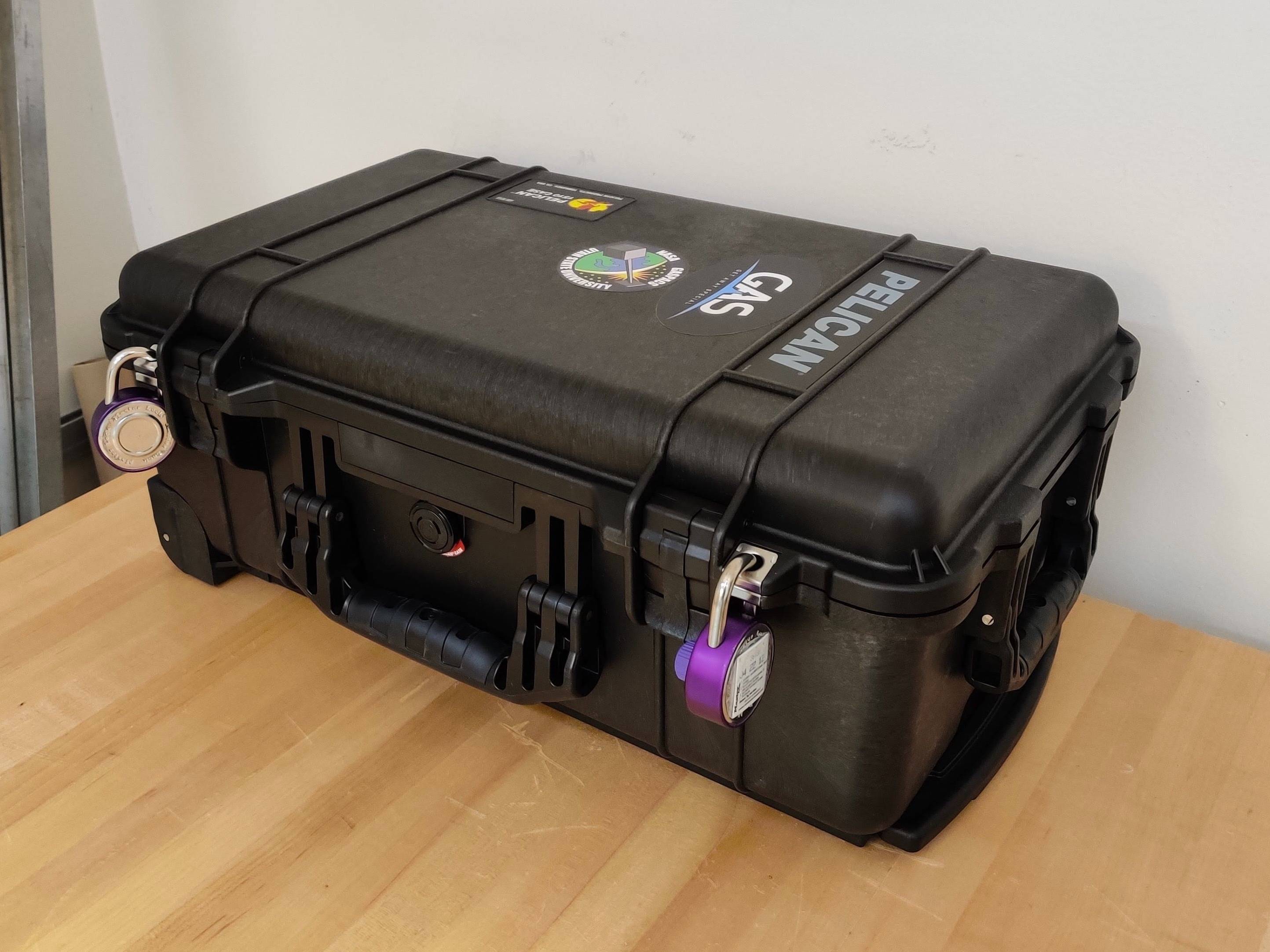
The Pelican case used to transport GASPACS.
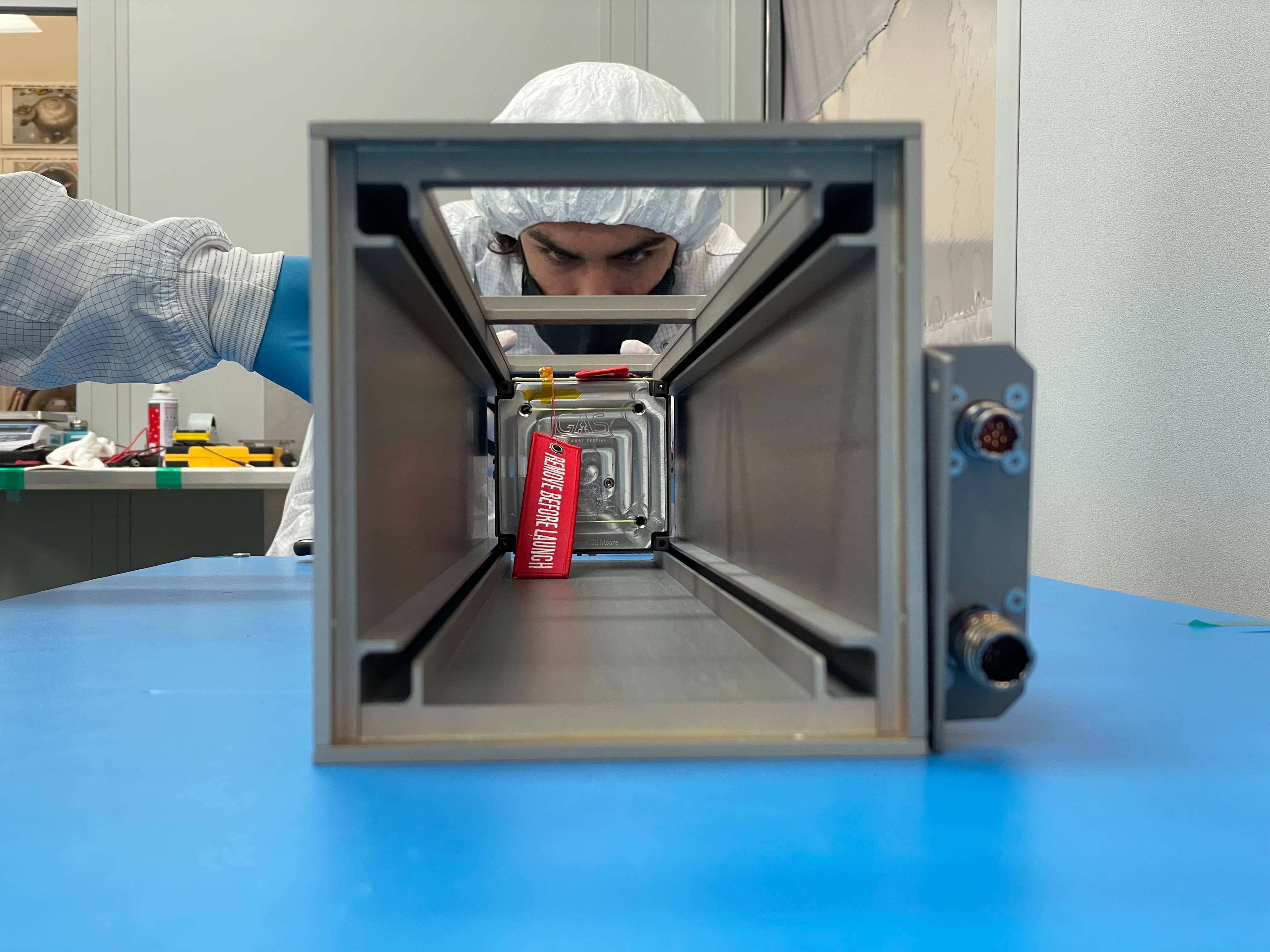
Danos inspects GASPACS' fit inside the NRCSD.
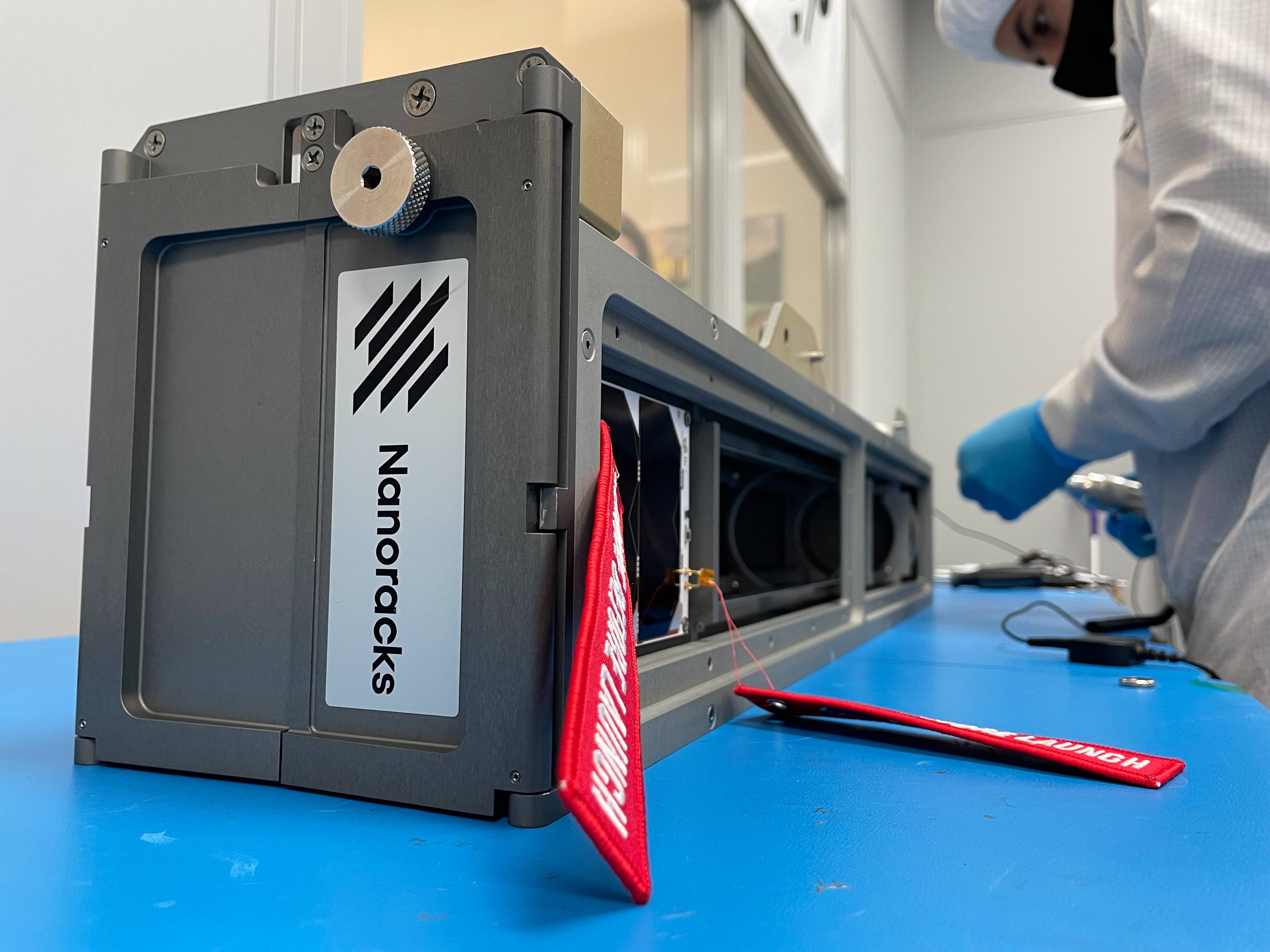
GASPACS inside the NRCSD.
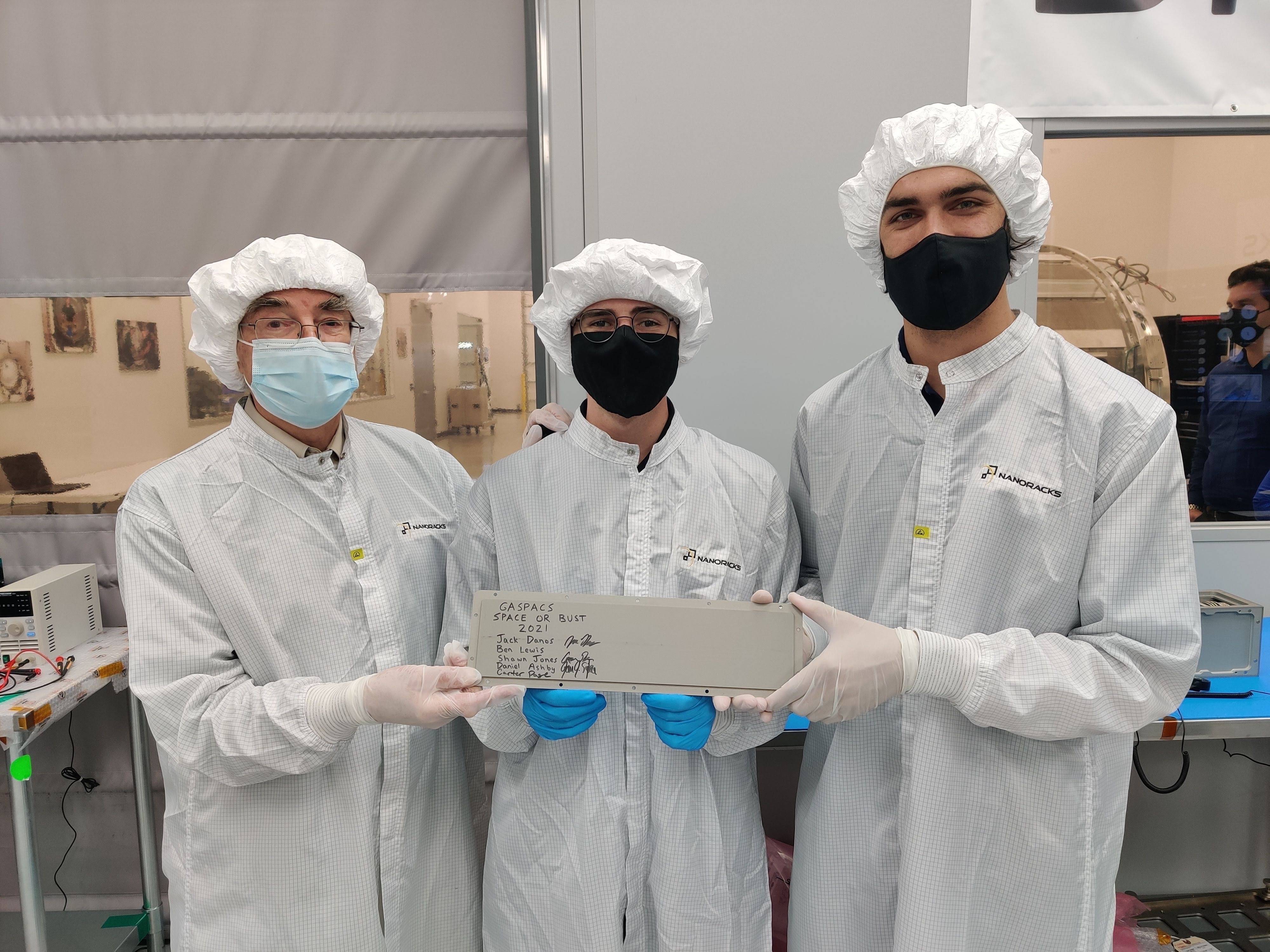
Sojka, Page, and Danos with the NRCSD cover.

The NRCSD cover, signed by the team.
Launch
GASPACS launched from LC-39A at Kennedy Space Center on December 21, 2021, on board the SpaceX CRS-24 ISS resupply mission. Flying on Falcon 9 B1069.1 and Cargo Dragon C209-2, GASPACS arrived at the ISS the following day.
Ten GAS Team members traveled to Florida to watch the launch. Leading up to the early morning launch time, a scrub was expected because of a 70% chance of weather violation. However, the range was somehow declared green at T-14, and the countdown went on. At 5:07 AM in the pouring rain, the team watched as the Falcon 9 launched, taking GASPACS to space.
While in Florida, the team was also treated to a special tour of Cape Canaveral Space Force Station, including some of United Launch Alliance's facilities.
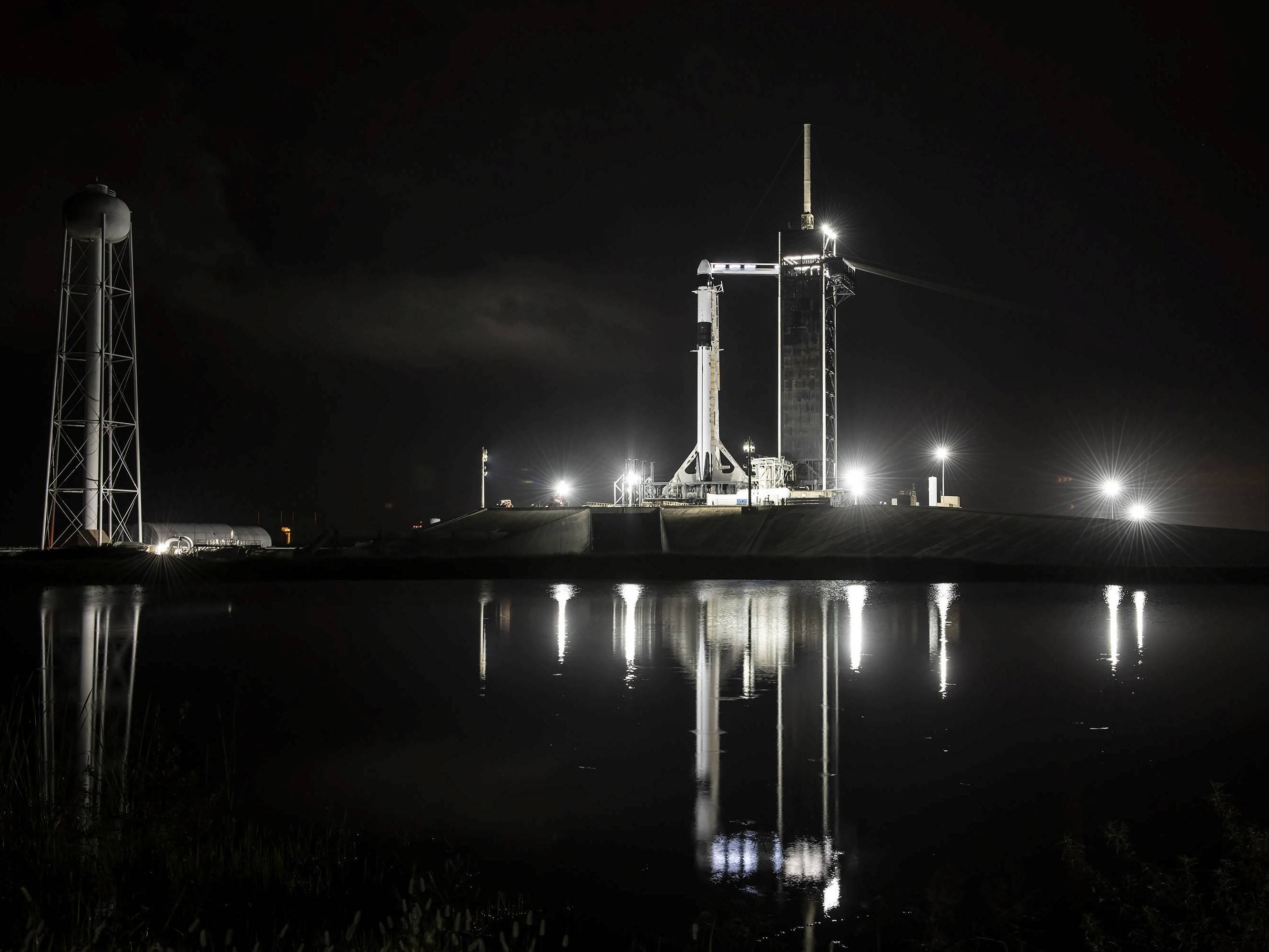 CRS-24 on pad LC-39A, awaiting its early morning launch time.
CRS-24 on pad LC-39A, awaiting its early morning launch time.
 CRS-24 lifts off into the clouds, carrying GASPACS into space.
CRS-24 lifts off into the clouds, carrying GASPACS into space.
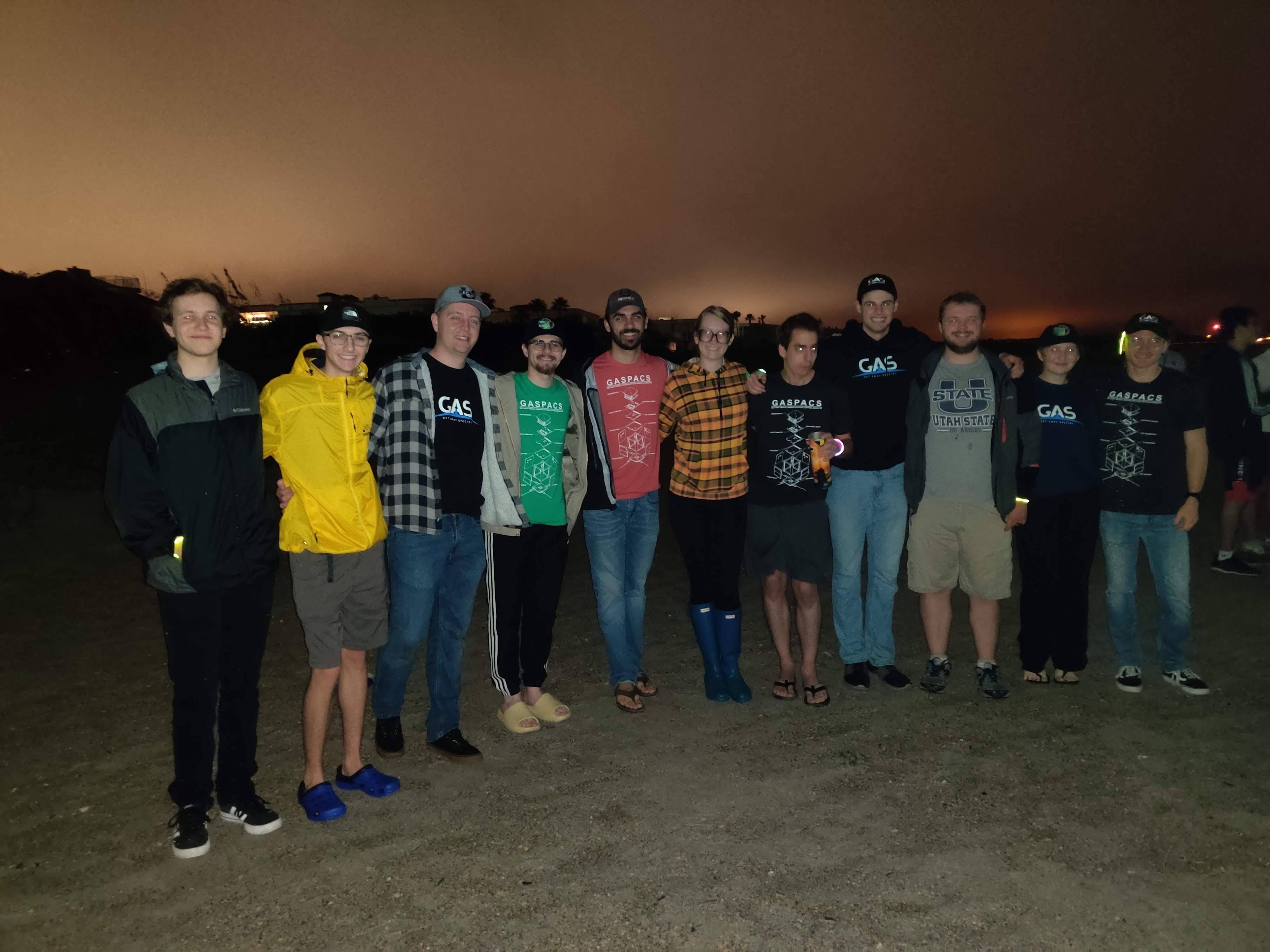 The team gathered at the beach to watch the launch.
The team gathered at the beach to watch the launch.
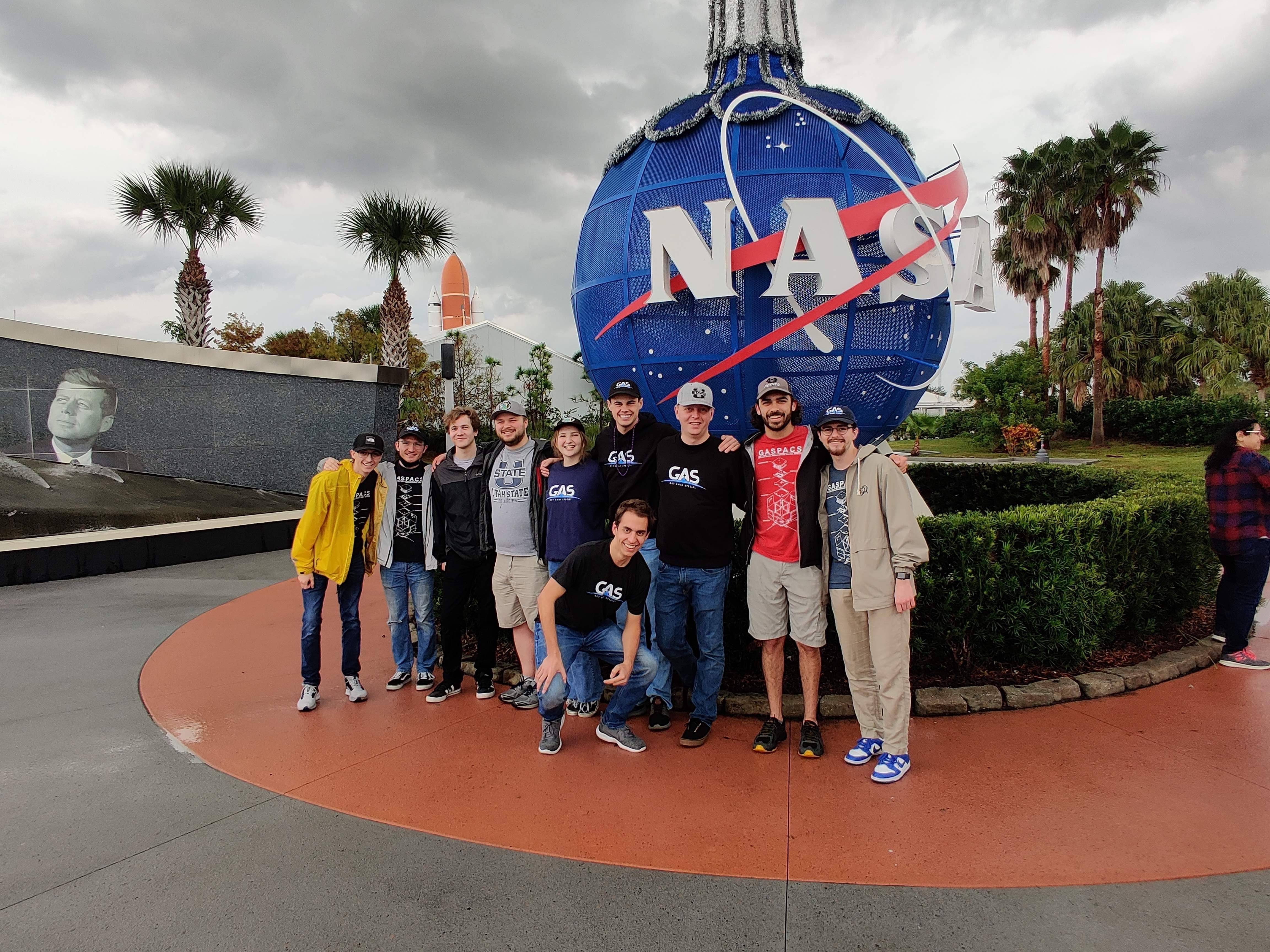 The team visiting the Kennedy Space Center Visitor Center.
The team visiting the Kennedy Space Center Visitor Center.
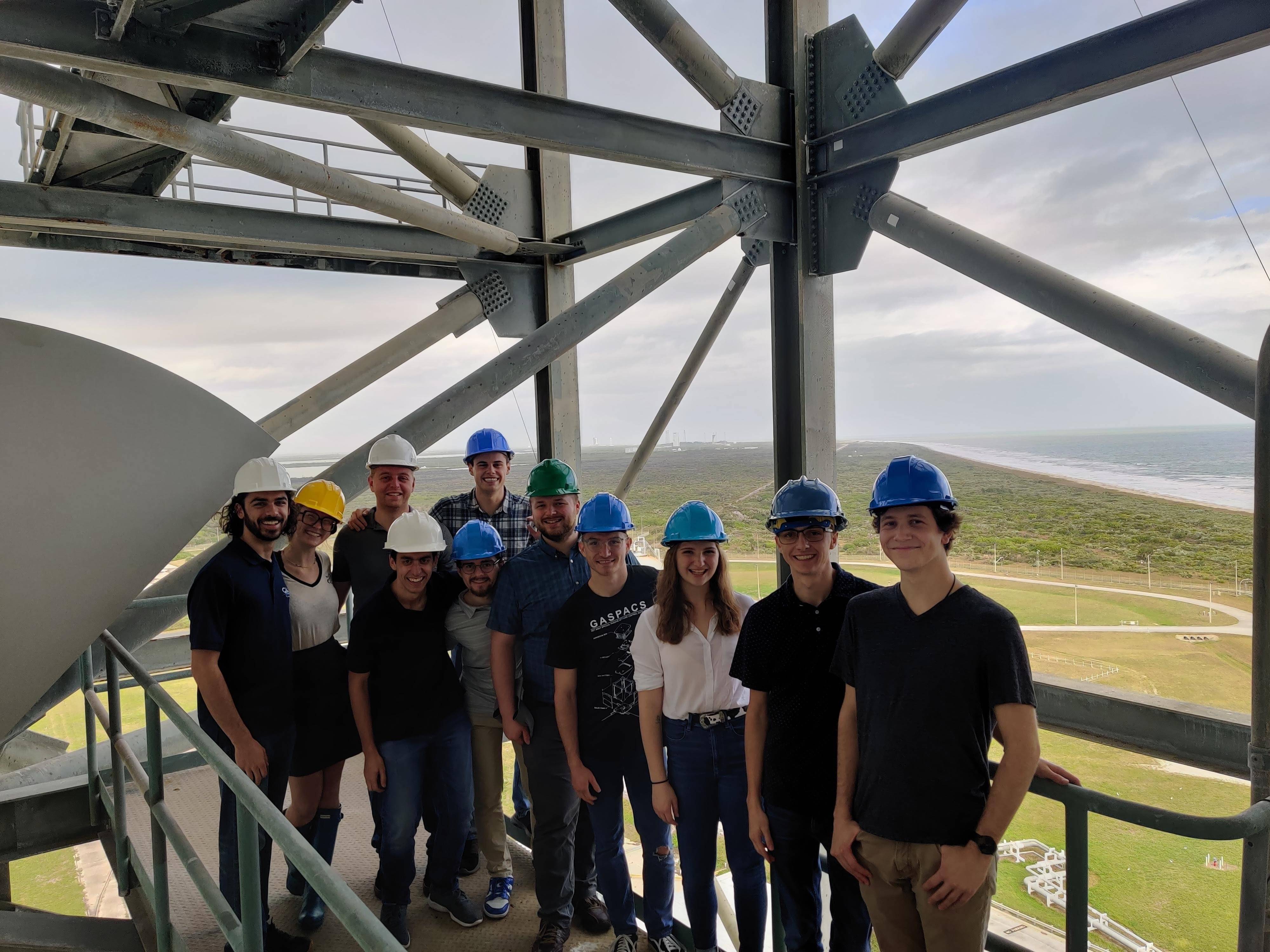 The team on top of the Delta IV Mobile Service Tower at SLC-37.
The team on top of the Delta IV Mobile Service Tower at SLC-37.
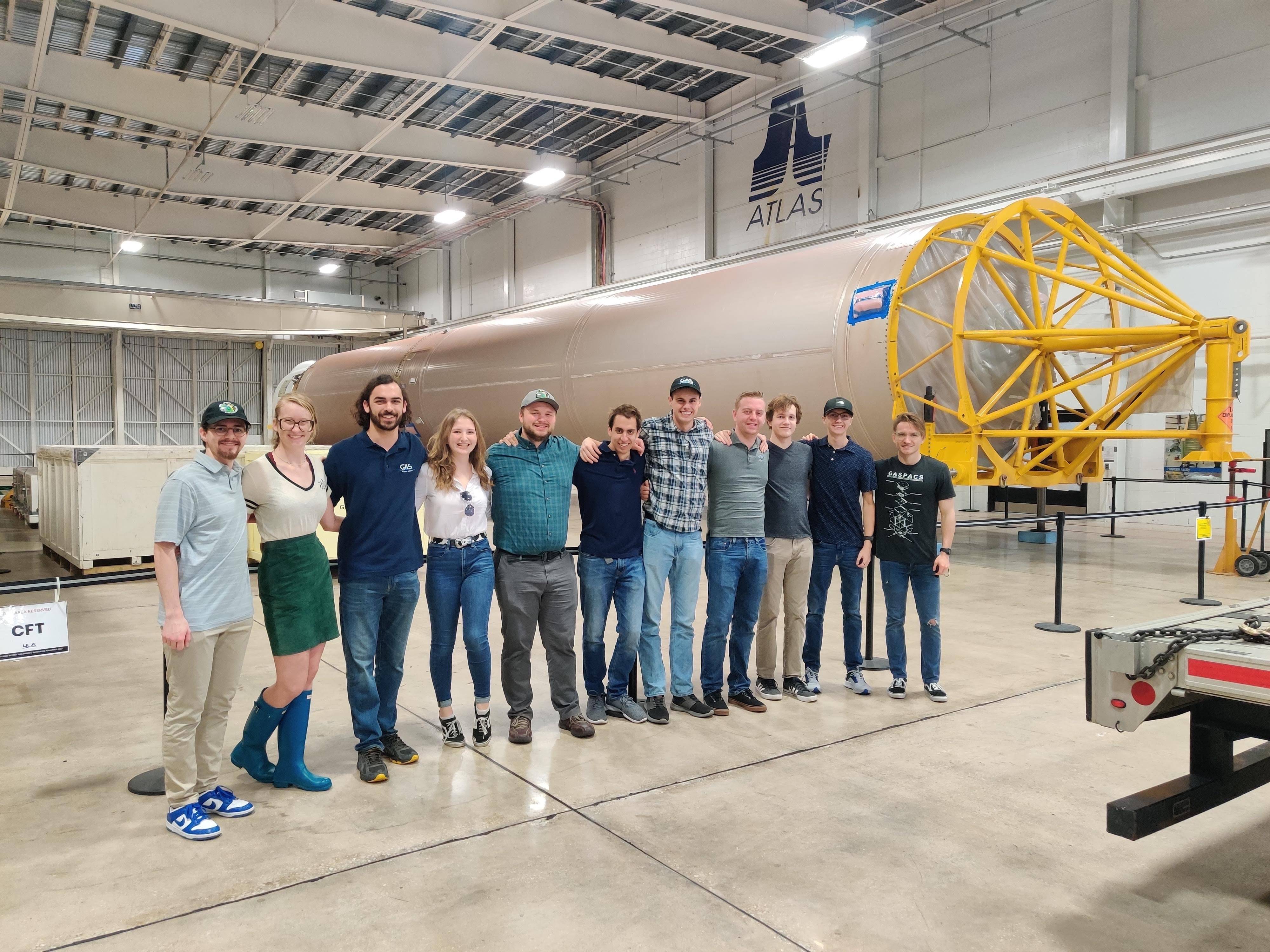 The team at the Atlas Spacecraft Operations Center.
The team at the Atlas Spacecraft Operations Center.
ISS Deployment and Mission Start
On January 26, 2022, at 12:00 UTC, GASPACS was deployed from the International Space Station, marking the beginning of the GASPACS mission. GASPACS, along with FEES-2, were removed from the Japanese Experiment Module (JEM) Airlock and deployed away from the ISS over the South Atlantic Ocean, between South America and Africa.
Keeping with ISS rules, GASPACS waited 30 minutes before booting up and deploying the antenna. Team members, family, and faculty waited patiently for the first signs of life from GASPACS. Just 47 minutes after deployment, the team got its sign as GASPACS was heard on a SatNOGS station over Tokyo, Japan, with The Scotsman ringing loud and clear!

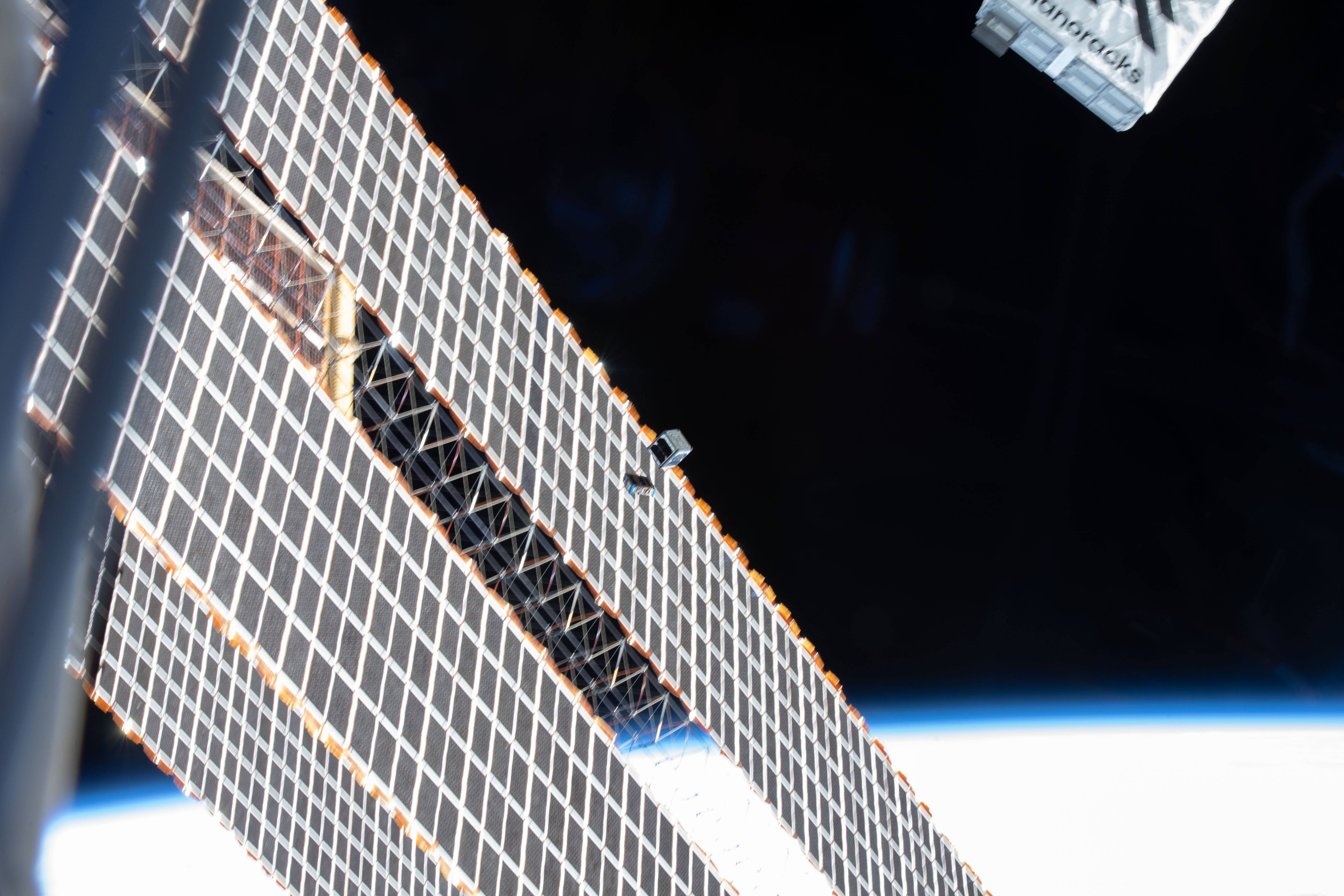


GASPACS (larger) and FEES-2 (smaller) are deployed from the International Space Station. Photos taken by NASA Astronaut Mark T. Vande Hei.
Mission Operations
Over GASPACS's 117 days in space, the team was hard at work trying to get data down from GASPACS every day. The first picture, LQ0, was received on the team's ground station just 18 hours after deployment! With LQ0, the primary mission objective was fulfilled!
Three days into the mission, GASPACS lost charging on the Y-axis solar panels. As a result of this, GASPACS became very power negative, meaning it used much more power than it could generate. This was reflected in GASPACS's ontime. GASPACS would typically be turned off and charging for around six hours, and then be on for about an hour.
Despite losing two solar panels, GASPACS continued on, sending down numerous incredible images and some great data. The magnetometer data shown below is from AeroBoom deployment, and clearly details how the AeroBoom affected the roll rate of GASPACS, completing the second mission objective.

LQ0
 LQ1
LQ1
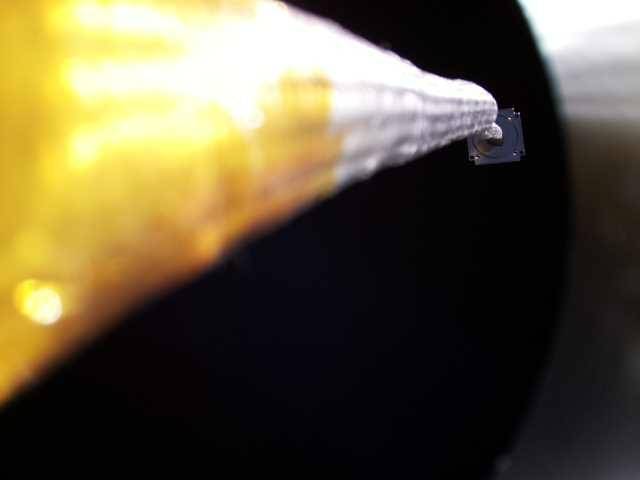
LQ2
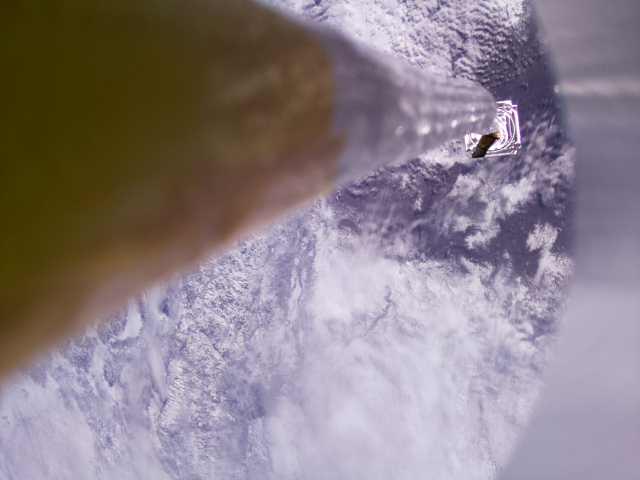 LQ4
LQ4
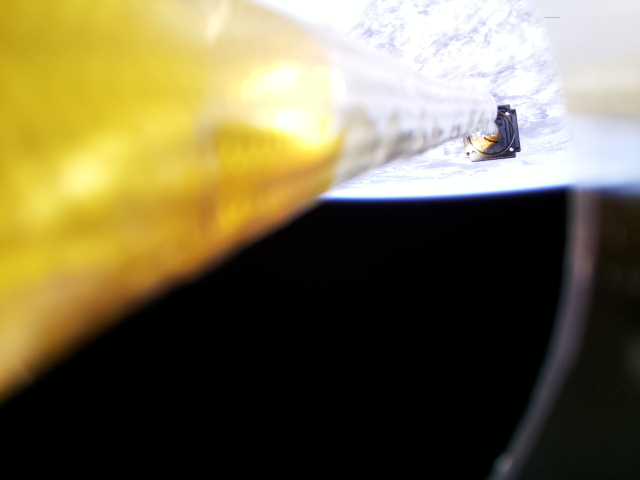 LQ9
LQ9
 LQ10
LQ10
 HQ1
HQ1
 Magnetometer data from GASPACS, taken from AeroBoom deployment.
Magnetometer data from GASPACS, taken from AeroBoom deployment.

